|
|
|
| Medieval Italy AD 400 - 1240 During and following the decline and fall of the Western Roman empire, Italy for the most part remained divided. Various powers such as theGoths, theOstrogoths, the Eastern Romans in the form of the exarchate of Ravenna, and then the Lombards vied for power until the peninsula was conquered by theCarolingian empire. It was the wars between Ravenna and the Ostrogoths and then the Lombards which effectively ensured Italy's division into separate states throughout the medieval and early modern periods. The Carolingian empire subsequently fragmented, with Francia Media controlling Italy and power passing from that to theHoly Roman empire in 961. |
|
|
| 476 |
On 4 September, a Gothic general of the Roman army takes Ravenna, killing Orestes and deposing Emperor Romulus. By this time the western Roman army has ceased to exist, starved to death by a steady decrease in recruiting grounds and a severe lack of funds to pay those troops who still remained, so that they have drifted off. With this coup, the Roman empire officially comes to an end in the West. 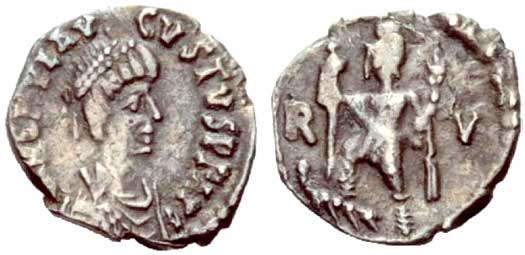 This half-siliqua was the only silver coinage issued during the short reign of Romulus Augustus, puppet and final official Western Roman emperor This half-siliqua was the only silver coinage issued during the short reign of Romulus Augustus, puppet and final official Western Roman emperor |
|
| 493 - 552 |
On 2 February, Theodoric and Odoacer sign a treaty that divides Italy between them, but at a banquet to celebrate the terms, Theodoric murders Odoacer with his own hands. Now unopposed, he is able to found a RomanisedOstrogothic kingdom of Italy based at the imperial capital of Ravenna. His accession is viewed by most Italians, Roman and Gothic, as a legitimate succession. The Ostrogoths rule Italy for the next half a century, until they are defeated at the Battle of Taginae, although theEastern Roman empire begins making inroads from 536, |
|
|
|
|
| Byzantine Exarchate of Ravenna AD 552 - 754 The imperial court of the Western Roman empire had been moved from Milan to the more easily defendable location of Ravenna, located in the middle of an area of swamp and marsh, in 402 by the Emperor Honorius. As well as offering landward protection, Ravenna had an ideal harbour which exited into the Adriatic and allowed easy lines of communication with the Eastern Roman capital at Constantinople. When the West fell to Odoacer'sGothic kingdom, the Eastern Romans were in no fit state to immediately recover it. Instead, they invited the Ostrogoths to invade and rule Italy for them, and good relations were maintained until the Ostrogothic kingdom started to fall apart from within. By that time, the Eastern Romans were much stronger, and Italy was in their sights as part of the restoration of a single Roman empire. |
|
|
| Prelude The strong sixth century reign of Emperor Justinian I saw a successful campaign under General Belisarius which began the long process of recapturing much of Italy for the Eastern Roman empire. It was certainly a long process, however, taking nearly twenty years against an Ostrogothic enemy that was revived and hardened by a determined King Baduila. He employed sensible tactics against the much larger Roman forces and maintained a disciplined and ordered army. After over a decade of leading the fight, he was finally killed in battle in 552, and with that Ostrogothic resistance was virtually over. The exarchate at Ravenna became the centre of Eastern Roman rule in Italy, including the marsh region which later became Venice. But its function was somewhat compromised by the invasion of theLombards into northern Italy. |
|
|
| 533 - 535 |
The [Vandali](BarbarianVandals.htm#Vandals and Alans) King Hilderic had been a close friend of Eastern Roman Emperor Justinian, so in response to Gelimer's usurpation, General Belisarius is sent to North Africa with an army. Gelimer has already sent the bulk of his forces to Sardinia to recapture the island, so the invasion by Belisarius begins with an immediate victory at the Battle of Ad Decimum. In one campaigning season the Vandali are conquered, and Sardinia becomes a possession of the Eastern Roman empire. North Africa also remains firmly in Roman hands as the exarchate of Africa. It apparently also provides the template for a general reorganisation of the empire under Emperor Heraclius into military districts and themes. With the empire now resurgent in the Western Mediterranean, the island of Sicily is recaptured in 535, and General Belisarius proceeds from his post as military tribune in North Africa to enter Italy. |
|
| 535 - 540 |
Belisarius |
Eastern Roman military governor. Formerly governed North Africa. |
| 536 - 540 |
After arriving in Italy before the close of the previous year, General Belisarius captures Naples and enters Rome, shortly before it is besieged by the Ostrogoth King Vittigis. The city suffers starvation until the siege is lifted in 537, and Belisarius pursues his opponents to Ravenna where they are defeated and Vittigis is killed in 540. Belisarius is subsequently recalled to Constantinople by the emperor, suspicious that he may attempt to claim the throne. 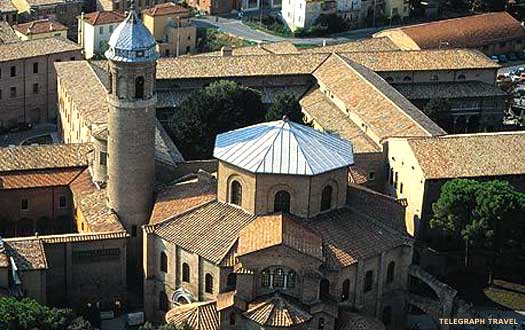 Ravenna had been the home of the last Roman emperors, as well as the capital of the succeeding Goths and Ostrogoths, before serving the same role for the Eastern Romans Ravenna had been the home of the last Roman emperors, as well as the capital of the succeeding Goths and Ostrogoths, before serving the same role for the Eastern Romans |
|
| 541 |
At last blessed with a strong and determined ruler once again, theOstrogoths under Baduila immediately collect together to throw off a badly organisedEastern Roman attack on their stronghold at Verona. Baduila is determined to win back control of Italy in the face of the creeping Roman conquest. Belisarius is kept in Constantinople by the emperor who is jealous of his success. |
|
| 542 - 544 |
The Ostrogoths win the Battle of Faventia (modern Faenza) in spring 542, but very quickly an even greater success aids them. Shortly after the 'Plague of Justinian' strikes Constantinople with the arrival of bubonic plague, it quickly spreads to Italy. TheEastern Roman empire is devastated by it, and is critically weakened at the point at which it is about to conquer all of Italy and bring it under the rule of one Roman emperor for the first time since 395. In 544, Belisarius returns to Italy to find that things have changed considerably. |
|
| 544 - 548 |
Belisarius |
Reappointed to Italy by the emperor. Later retired. |
| 546 - 549 |
With Belisarius being starved of reinforcements by Emperor Justinian, the Ostrogoths recapture Rome under the leadership of Baduila. An attempt by the much largerEastern Roman forces to relieve it narrowly fails and it is sacked by the otherwise merciful and disciplined Ostrogoths. However, they withdraw to Apulia and the see-saw battles continue, with the Ostrogoths generally avoiding the strongly-defended cities. Over the next three years, the Romans find themselves on the back foot, losing rather than gaining ground in Italy. |
|
| 549 |
Eastern Roman Emperor Justinian appoints his cousin, Germanus, to take command of operations in Italy. He is to lead a major new expeditionary force with orders to turn around the poor situation in the war against the Ostrogoths. Germanus is replaced by Liberius before the expeditionary force even gets under way, and then it is cancelled altogether. |
|
| 549 |
Germanus |
Of Africa? Appointed but replaced before departing. |
| 549 |
Liberius |
Appointed but expedition cancelled. Sent toSicily instead. |
| 550 - 551 |
The plan to send a major expeditionary force to Italy is resurrected, and Germanus is reappointed to command it. However, Germanus falls ill on his way to Italy and dies. Narses, having served as sub-commander alongside Belisarius, is designated as his replacement. |
|
| 550 |
Germanus |
Reappointed as commander in Italy but died on the way there. |
| 551 - 552 |
Narses / Narsete |
Appointed to take command of all operations in Italy. |
| 552 - 553 |
The death of Totila of theOstrogoths at the Battle of Taginae allows Rome to be retaken by the Eastern Romans, who then govern Italy from Ravenna. A final defeat in battle near Mount Vesuvius in 553 means the death of the last Ostrogothic king and the end of their rule in Italy. The exarchate of Ravenna is now the main centre of power in Italy, although not the only one. |
|
| Exarchate With the destruction of theOstrogoth threat, theEastern Roman empire now controlled large areas of Italy. The city ofRome and the papacy remained dominated by Constantinople until the eighth century, although a civil government slowly emerged to take control of Roman regional affairs in the late ninth century, often vying for power with the pope. However, Eastern Roman authority was theoretical in some places where Roman forces were spread thinly, and a new threat to peace quickly materialised when theLombards entered northern Italy. The exarch in Italy was the direct military and civil representative of the Eastern Roman emperor, and as such he wielded considerable power. He directly controlled much of Italy's Adriatic coast, with territory comprising Ravenna itself, plus the Pentapolis, a strip of five Adriatic coastal cities immediately to the south, and the duchy of Perugia immediately south of that. There were also a host of other territories which were governed by magister militum and dux, including Calabria, Campania, Emilia and Liguria, the Urbicaria around Rome, and Venice. Areas in Italy which were outside the exarch's control wereCorsica, Sardinia, and Sicily. In later years, the exarch was often regarded as a foreign intruder, and he could find his best efforts being blocked not only by the Lombards, but also by Rome and others who supposedly answered to him. As a result the exarchate gradually faded in strength until it became easy prey to conquest. |
|
|
| 552/3 - 567/8 |
Narses / Narsete |
Eastern Romans eunuch general, liberatedRome. |
| 568 - 569 |
TheLombards enter northern Italy, intent on conquering it and creating their own kingdom. The first Roman city to fall is that of Forum Iulii (now Cividale de Friuli), with smallEastern Roman defensive forces from Ravenna unable to offer any viable opposition (and perhaps not even bothering to try). The first Lombard duchy is created here, the duchy of Friuli. In the same year, Vicenza, Verona and Brescia also fall to Alboin, followed by a great prize in the capture of Milan. The north belongs to the Lombards. 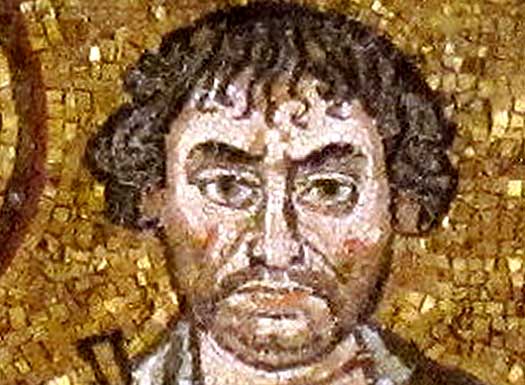 Although unconfirmed, the mosaic in the Basilica of San Vitale that depicts Emperor Justinian and his entourage includes this man who is usually identified as General Narses Although unconfirmed, the mosaic in the Basilica of San Vitale that depicts Emperor Justinian and his entourage includes this man who is usually identified as General Narses |
|
| 568 - 573 |
Longinus |
Last military governor. |
| 569 - 571 |
Eastern Roman Emperor Justin II sends Longinus to stem theLombard advance, but he can do little more than defend the coastal territories with the powerful Byzantine fleet. Inland, territorial gains to the south of the exarchate are quickly formalised in the shape of the duchies of Benevento and Spoleto.Rome is temporarily isolated during this period and records destroyed, leaving little information about the pontificate of John III. |
|
| 572 |
After a siege lasting three years, the city of Pavia falls to theLombards. They make it the first capital of their new kingdom. Although Ravenna manages to retain control of the region around this imperial city, and also re-securesRome through a narrow corridor of territory running through Perugia, the Lombards still have free access to central southern Italy and their conquests there. Apart from much of the coastline, Ravenna also controls the extreme south of Italy, below Benevento, along withCorsica,Sardinia, Sicily, and a wide strip of territory between Rome and Lombardic northern Italy. |
|
| 573 - 575 |
Ravenna is almost certainly behind the murders of the powerfulLombard king, Alboin, in 573, and his successor in 575. Such plotting removes a powerful figure of opposition, severely damages Lombard unity, and raises the possibility of the Eastern Roman reconquest of Italy. The Lombards largely remain divided, unable to organise any significant further conquests, and a balance of power is established in Italy. |
|
| 575 - 576 |
Baduarius |
First exarch. Killed in battle. |
| 576 |
Baduarius, son-in-law of Eastern Roman Emperor Justin II, is defeated and killed in battle. Due to the Roman focus on their eastern borders and crisis in the Balkans, there are no extra resources to devote to Italy. Therefore, Roman authority is limited to large pockets of territory, including Ravenna andRome. |
|
| 576 - 585 |
Decius |
|
| 580 |
Eastern Roman Emperor Tiberius II reorganises the surviving Roman territories in Italy into five provinces which are given the Greek name eparchies. This use of Greek instead of Latin is part of a gradual shift for the Eastern Romans away from their Italian roots and towards greater integration with their permanent homeland in Greece. The new provinces are the Annonaria in northern Italy around Ravenna (which incorporates the duchy of the Pentapolis, a strip of five Adriatic coastal cities immediately south of Ravenna, and below that the duchy of Perugia, both governed directly from Ravenna), the duchy of Calabria (although some areas are lost toBenevento), the Campania, Emilia and Liguria (only nominally), and the Urbicaria around the city of Rome (Urbs). To the north, across the River Po, the duchy of Venice remains nominally under the service of the Eastern Romans. |
|
| 584/585 |
The Lombards invade the Merovingian Frankish region of Provence. In return, the Frankish king of Austrasia, Childebert II, and Guntramn, king of Burgundy, invade Lombard Italy. They capture Trent and open negotiations with theEastern Roman emperor via Ravenna, perhaps with a view of carving up Italy between them. The Lombards, fearing Frankish domination, elect a king to end their disunity. He is successful in throwing out the invaders and restoring the strength of the kingdom. 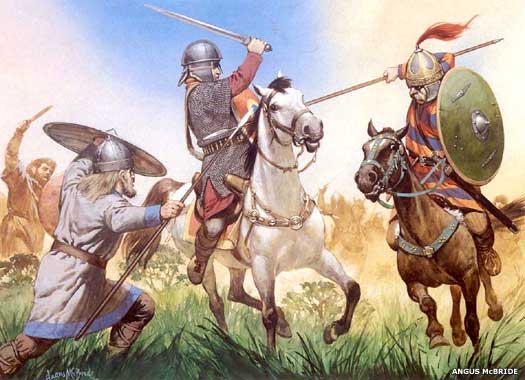 An artist's impression of mixed Lombard infantry and cavalry in action, exhibiting Late Roman and Germanic features in their dress and weapons An artist's impression of mixed Lombard infantry and cavalry in action, exhibiting Late Roman and Germanic features in their dress and weapons |
|
| 585 - 589 |
Smaragdus |
Removed from office due to his violence & charges of insanity. |
| 588 |
Smaragdus is able to recover Classis, the port of Ravenna, from the Lombards, but overall is not able to make any great impact in pushing them back. Alliances with the Avars and Franks come to nothing as the Franks, at least, are not particularly interested in conducting campaigns into Italy. |
|
| 589 - 598 |
Romanus |
Died in office. |
| 589 |
Romanus is able to recover the cities of Altinum, Mantua, Modena, Parma, Piacenza, and Reggio from the Lombards during one extremely successful year of campaigning. |
|
| 598 - 603 |
Callinicus / Kallinikos / Gallicinus |
Recalled and replaced. |
| 601 - 603 |
King Agilulf of Lombardy fights a successful series of campaigns against rebel dukes in northern Italy, capturing Padua in 601, and Cremona and Mantua in 603. He is also successful in forcing the exarch of Ravenna to pay a sizable tribute.Eastern Roman Emperor Phocas restores Smaragdus to the position of exarch, but even he cannot hold onto Cremona and Mantua. However, the peace he establishes by releasing Lombard prisoners lasts for the remainder of his term of office. |
|
| 603 - 611 |
Smaragdus |
Restored. Died shortly after being removed from office. |
| 611 - 615 |
John I Lemigius |
Murdered along with several other officials. |
| 616 - 619 |
Eleutherius |
A eunuch. Declared himself emperor in 619. Killed 620. |
| 616 - 617 |
Eleutherius puts to death all those who are implicated in the death of his predecessor, but immediately Naples is withdrawn from his control by one John of Conza. Eleutherius marches on the city, retakes it and kills the rebel. To make the situation worse the Lombards threaten to attack, so they have to be bought off with promises of an annual tribute. |
|
| 619 - 620 |
Following growing discontent with the exarchate'sEastern Roman masters, Eleutherius notes the emperor's focus is on fighting the Sassanids and takes the opportunity to declare himself emperor. In 620 he marches on Rome, intent on making it his capital, but he is murdered by his own troops. |
|
| 620 - 637 |
Isaac the Armenian |
Died, presumably in fighting against the Lombards. |
| 638 - 648 |
Plato |
Sometimes placed after the first term of Theodore I. |
| 638 |
In response to the rebellion of John of Conza, the exarchate creates the duchy of Naples, the sixth such division ofEastern Roman territories in Italy. A dux or duke is brought into Italy to command Naples, and he reports directly to the strategos of Sicily. The new duchy is similar in size and territory to the modern province of Naples. |
|
| 643 |
One of the most active of Lombard kings since Alboin, Rotharis conquers the survivingEastern Roman territories of Linguria (Liguria) and Inner Veneto, dealing another blow to the fading authority of the exarch at Ravenna. Several thousand Roman soldiers are killed in battle and, according to some sources, Exarch Isaac is either also killed or dies of a stroke following the battle. Either way, while this seems to link him to 643, other sources end his term of office in 637. It is possible that two different battles and defeats have been merged into one. |
|
| 648 - 649 |
Theodore I Calliopas |
Succeeded Isaac or Plato (sources differ). |
| 649 - 652 |
Olympus / Olympius |
Declared himself emperor in 652. Died of illness. |
| 652 |
Frustrated by his attempts to remove Pope Martin from office under the orders of Eastern Roman Emperor Constans II, Olympus switches his allegiance. Now supporting the pope, he declares himself emperor. In the same year he marches into Sicily, although who he is about to fight, the Roman strategos or the Arabs, is not clear. Instead he is struck down by disease and dies. 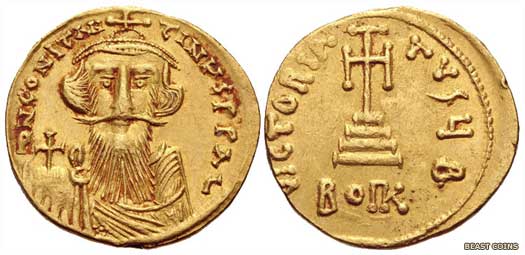 This light solidus was minted during the reign of Emperor Constans II, with his bearded face on the obverse (left) and a cross potent on three steps on the reverse (right) This light solidus was minted during the reign of Emperor Constans II, with his bearded face on the obverse (left) and a cross potent on three steps on the reverse (right) |
|
| 652 - 666 |
Theodore I Calliopas |
Restored. Died. |
| 653 |
The newly restored Theodore is ordered by the Eastern Roman emperor to arrest Pope Martin I, as his election had not been referred to the emperor for approval. Theodore enters Rome and his soldiers drag the pope from the Lateran. Martin is packed onto a ship and sent into exile in Crimea, but it takes a year before the Romans to elect a new pope. |
|
| 661 |
Eastern Roman Emperor Constans II is highly interested in affairs in southern Italy, which causes him to move his capital to Syracuse on Sicily. He appoints a native ofNaples, one Basil, as the new dux, the military commander of the city. This is not the first dux to be appointed, but it seems to be the first about whom anything concrete is known, the previous incumbents being foreigners who had been forced to answer directly to the strategos of Sicily. Now Naples is its own master. |
|
| 666 - 678 |
Gregory |
|
| 678 - 687 |
Theodore II |
Confirmed Pope Conon in office in 686. |
| 683 |
Following the short-lived declaration of independence by the archbishop of Ravenna (about 670-678), the independence of the see of Ravenna is suppressed.Rome's rights over the see are confirmed by Eastern Roman Emperor Constantine IV. |
|
| 687 - 702 |
John II Platinus / Platyn |
|
| 687 |
The rivalry between the two candidates for the papacy - Paschal and Theodorus - erupts into open conflict before a third candidate, Sergius, is electedPope. Paschal offers John II Platinus gold in exchange for military support. The exarch arrives in Rome to collect his gold, and collects it by looting St Peter's (Old) Basilica, before departing back to Ravenna. Paschal is arrested and confined to a monastery on charges of witchcraft. |
|
| 697 |
The Eastern Roman tribunes are substituted in Venice with an elective, life-long office. It is another loss of power in Italy for Constantinople. The process of once imperial positions passing into the hands of a local or settled elite is ongoing throughout Italy. Militia units are gradually formed to protect local imperial interests, but eventually drift into local control, taking more authority and power away from Constantinople. All of this leads to the creation of vested interests that are different from those of the exarchate, thereby weakening it. |
|
| 702 - 710 |
Theophylactus |
|
| 709 |
The exarchate is further weakened, this time by the Eastern Roman emperor himself. Justinian II sends an expedition against Ravenna, commanded by the patrician Theodore. The reason is not clear, but it may be related to a rebellion which involved some of the city's inhabitants and which dethroned Justinian in 695. Theodore invites all of Ravenna's leading citizens to attend a banquet, where they are captured as they arrive and thrown onto a ship to be taken back to Constantinople. The city itself is subsequently sacked. Exarch Theophylactus is apparently not involved either in prosecuting or defending against the action, but he is replaced in the following year. |
|
| 710 - 711 |
John III Rizocopo |
Involved in tidying up the repercussions of 709, brutally. |
| 711 - 713 |
Entichius |
Also involved in putting down revolts following the 709 events. |
| 713 - 726 |
Scholasticus |
|
| 724 |
In documents that are disputed in terms of their authenticity,Lombard King Liutprand cedes various properties in Lugano to the Church of Saint Carpophorus in Como. The town remains under the rule of the Rusca family in Como, which lies approximately midway between Lugano and Milan, at the very foot of Lake Como (in modern Italy, just inside the border withSwitzerland). |
|
| 726 |
The Lombards take control of the exarchate. As a result,Eastern Roman imperial authority is temporarily unrecognised in Italy, marking a break in Constantinople's control over thePapacy. |
|
| 727 |
Paul |
UnderLombard control. |
| 728 |
TheEastern Romans recover the exarchate, although control over Venice is weaker now that the city has its own elected doge in place of a Roman tribune (there is a school of thought which suggests that the doge and Exarch Paul are one and the same person, although the dates of office do not match up). The remaining territory within the exarch consists of Ferrara,Istria, the Pentapolis, Perugia, and Ravenna's immediate surroundings. 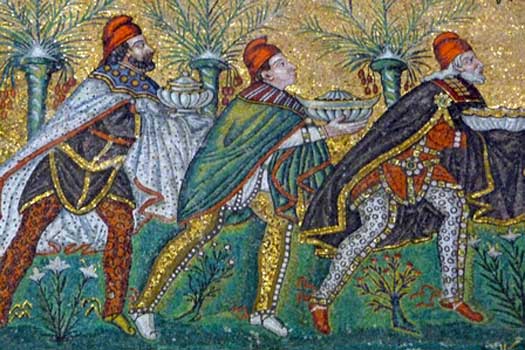 During the two centuries of Byzantine dominance in eastern Italy, the Eastern Romans left behind a good deal of their Greek-based culture, including these mosaics at Ravenna During the two centuries of Byzantine dominance in eastern Italy, the Eastern Romans left behind a good deal of their Greek-based culture, including these mosaics at Ravenna |
|
| 728 - 752 |
Eutychius |
Under Eastern Roman control. Killed by Lombards. |
| 752 - 754 |
The exarchate is recaptured by the Lombards, permanently ending Eastern Roman influence in much of Italy. In the south, the catepanate of Italy at Bari is reorganised as the chief Byzantine authority in its remaining territories. In 754,Rome is delivered fromLombard attack by Pepin III, king of the Franks. This fulfils his role as the ordained protector of the church following Pope Stephen's visit to Paris, during which he re-consecrated the Frankish king. The ex-Eastern Roman exarchate of Ravenna is transferred to the pope in the form of the Papal States. |
|
| 755 - 756 |
The exarchate is briefly re-captured by the resurgent Lombards in 755, but the following year the Carolingian Franks recapture the territory. The ex-Eastern Roman exarchate is handed back to Rome as the Papal States and northern Italy becomes part of the Carolingian empire. The Papal States are autonomously controlled by the archbishops of Ravenna until 1218. The Lombards remain in power in northern Italy (despite being subjects of the Carolingians) while the Papal States control upper central Italy. Two independent Lombard states, Benevento and Spoleto, control much of the southern central region, while the far south remains in Byzantine hands. |
|
| 755 - 768 |
Pepin III |
King of theFranks. Nominal overlord of northern Italy. |
| 768 - 781 |
Charles the Great / Charlemagne |
King and emperor of the Franks. |
| 774 |
Daufer, king of the Lombards, invades the papal territories, andPope Adrian is forced to call upon the Frankish King Charlemagne for support and aid. Charlemagne enters Italy and breaks the Lombards, taking the title of 'king of the Lombards' for himself. Rome gains part of the Lombard duchy of Benevento out of the conquest while the rest signals its independence as a continuation of the Lombard kingdom. |
|
| 781 |
Pepin, son of Charlemagne, is given command of the Italian portion of the Frankish empire, which includes the former Lombard territories. He also gains the iron crown of the rex Langobardum (king of the Lombards), and it remains in use by the Frankish kings ofItaly. |
|
|
|
|
| Carolingian Kings of Middle Franks (Francia Media / Italy) AD 781 - 888 The year 781 saw the final conclusion of the efforts of Frankish Emperor Charlemagne to fully conquer and subdue theLombards in Italy. In that same year his second son, Pepin, was given command of the Frankish possessions in Italy, which largely consisted of the former territory of the Lombard kingdom in northern Italy. The Franks also dominated thePapacy, having saved it from the Lombards, and as the upholders of Western Christendom, they were looked to as the source of patronage and security. The Middle Franks (Francia Media in Latin) gained their name due to their geographical position between the [Western](FranceFranks.htm#Western Franks) andEastern Franks. Under Lothar I, Francia Media included all of central and northern Italy (the territory of the former exarchate of Ravenna and the Lombard kingdom), and the Rhine corridor up to the modern[ Netherlands](FranceHolland.htm#Kingdom of Holland %28Orange%29), which also included Switzerland. The imperial city of Aachen, Charlemagne's former residence, was included in this territory. However, this greatness was ephemeral. Lothar's death signalled its division under the Frankish practice of partible inheritance. His territory, which had never really bonded into a single entity thanks to its very different cultural backgrounds, was divided relatively equally between his three sons. Louis II received Italy and also retained his father's position as de facto head of the Frankish Empire. |
|
|
| 781 - 810 |
Pepin |
Son of Frankish Emperor Charlemagne. King of Italy. |
| c.790 - 791 |
Claimed both by the Carolingian Franks and Eastern Romans, the principality of Benevento is now attacked by the latter. Byzantine troops under the command of Adelchis, son of the last king ofLombardy, land on the coast of Italy around 790, but are almost immediately faced by a coalition of troops from Benevento, Spoleto and the Franks. The attack is successfully repelled, and the Franks think that they have retained nominal control over the region. However, Duke Grimoaldo of Benevento also resists them successfully, probably in the following year, and maintains the independence of his principality. 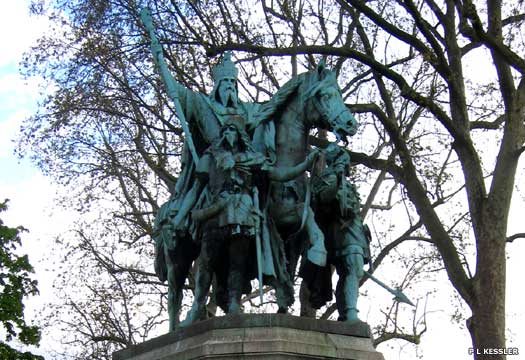 Charlemagne unified all the Frankish states under one ruler and created an empire which stretched deep into modern Germany, something that the Romans had never managed Charlemagne unified all the Frankish states under one ruler and created an empire which stretched deep into modern Germany, something that the Romans had never managed |
|
| 791 - 796 |
Pepin marches a Lombard army into the Drava valley to ravage Pannonia, with Duke Eric of Friuli assisting him. This strike is a diversionary tactic so that Charlemagne is able to take his own Frankish forces along the Danube into Avar territory. In 792 Charlemagne breaks off to handle a revolt by theSaxons, but Pepin and Eric continue to attack the Avars, taking their capital twice. The Avars are forced to submit in 796. |
|
| 810 |
A military expedition guided by Pepin to conquer the Venetian lagoons is stopped by the Venetian people themselves. Pepin's siege of Venice lasts for six months, but his forces are ravaged by disease borne by insects from the surrounding swamps and are in no fit state to fight off the Venetians. Pepin dies a few months later. The iron crown of the Lombards passes to his son Bernard, but upon the death of Charlemagne in 814, the empire goes to Pepin's younger brother, Louis 'the Pious'. |
|
| 810 - 818 |
Bernard |
Illegitimate son. King of Italy. |
| 814 - 818 |
Louis 'the Pious', the surviving son of Charlemagne, becomes Frankish emperor in 814, holding authority over Italy as well as his many other domains. Bernard remains on the throne, but as a vassal-to-be of Lothar, Louis' son. In 818, Bernard is implicated in a move to regain his full independence. He is captured by Louis and blinded, but dies in agony two days later. Louis replaces him on the Italian throne with Lothar, by now already the commander of theBreton March. |
|
| 818 - 840 |
Lothar I |
Nephew. Son of Louis 'the Pious'. King of Italy (&[Bavaria](GermanyBavarians.htm#Bavarian Confederation)). |
| 840 - 843 |
Louis I wills the Frankish empire to his sons, but tries to ensure that the eldest gains the biggest share in order to avoid the fragmentation of territory which so weakened the Merovingians. Lothar receives Middle Francia (the Rhine corridor including the kingdom of[Burgundy](FranceBurgundy.htm#Frankish Kingdom of Burgundy), and Italy, which includes the duchy of Spoleto); Charles 'the Bald' receives [Western Francia](FranceFranks.htm#Western Franks) (France and the duchy of Burgundy); and Louis the German receives Eastern Francia (Germany, includingAlemannia,[Bavaria](GermanyBavarians.htm#Bavarian Confederation), Khorushka, and Saxony, plus regions that are already emerging as Franconia and Thuringia). However, Lothar initially claims overlordship over all three regions and Louis and Charles have to go to war to convince him to relent. The Treaty of Verdun, signed in 843, recognises the division of the empire. |
|
| 840 - 855 |
Lothar I |
Lothar I of Francia Media, [Burgundy](FranceBurgundy.htm#Frankish Kingdom of Burgundy), & Empire. |
| 844 - 855 |
Louis II |
Son and co-ruler. Sole ruler following the death of his father. |
| 849 |
Louis intervenes directly in the ten year war between the new prince ofBenevento, Radelchis I, and the brother of the former prince, Siconulf. He formalises the division of Benevento between the principality itself and the city of Salerno, in Campania in south-western Italy. This city will form the capital of a new principality which also gains the cities of Capua, Cassano Irpino, Cimitile (Nola), Conza, Paestum, Sarno, Sora, Taranto, and Teano. In the same year, a fresh Aghlabid incursion threatens Rome and other Italian coastal cities, so the pope organises the creation of a defensive league. The league, under the command of Caesar, son of Sergius I of Naples, sails out to meet the Saracen fleet at the Battle of Ostia. A storm divides the participants halfway through the fight and the Italians return safely to port while the Saracens are scattered. Their remnants are easily picked off or captured afterwards and the successful defence of Italy is celebrated. |
|
| 855 |
Upon Lothar's death at Prüm Abbey in Lotharingia, Middle Francia is divided between his three sons. Louis II receives Italy and the imperial crown; Charles receives southern Burgundy, which includes Lyon, Provence, and Vienne, and which comes to be known as the kingdom of Provence; and Lothar II the remainder - the Rhine corridor from [Burgundy](FranceBurgundy.htm#Frankish Kingdom of Burgundy) up to the North Sea. This area has no traditional name of its own, so it is named after its ruler - Lotharingia (which later becomes Lorraine). |
|
| 855 - 875 |
Louis II |
Louis II of Italy & Empire. |
| 855 - 875 |
Louis' title of emperor has little meaning since he rules only in Italy, and even there his reign is constantly challenged by independentLombard dukes and by the Arab Aghlabid invaders of southern Italy. He supports his brother Lothar II, king of Lotharingia, in a dispute with the Pope, and briefly (864) occupies Rome. He subsequently submits to the pope. He also unsuccessfully tries to claim Lotharingia after Lothar's death. |
|
| 860 |
Duke Adelchis of Benevento is forced to play the traditional game of fending off the hostile intentions of both south and north, this time in the form ofAghlabid Islamic invaders in the south and the Middle Franks of Italy in the north. In 860 he is defeated by the Muslims at Bari and is forced to agree a truce. Subsequently, this forces him to call on the aid of Emperor Louis II. The emperor attempts to gain greater influence in Benevento, but Adelchis is able to fend him off as well as defeating a fresh Muslim invasion. |
|
| 875 |
Charles 'the Bald' of the [Western Franks](FranceFranks.htm#Western Franks) is crowned emperor of the Romans byPope John VIII and thereafter nominally rules Italy, and the Frankish Empire as Charles II. Boso is his viceroy in Italy and Provence (and later becomes independent king of the latter). 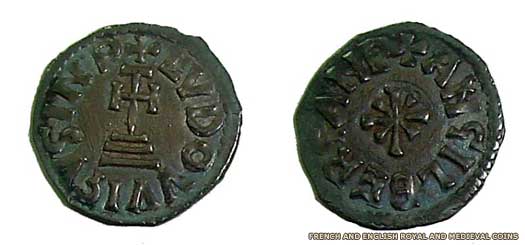 This denier was issued in Italy during the reign of Louis II, ruler of Middle Francia and nominal emperor of the Frankish realms, and was minted at Benevento This denier was issued in Italy during the reign of Louis II, ruler of Middle Francia and nominal emperor of the Frankish realms, and was minted at Benevento |
|
| 875 - 877 |
Charles 'the Bald' |
Charles II of [Western Franks](FranceFranks.htm#Western Franks), Italy & Empire. |
| 875 - 877 |
Boso |
Viceroy of Italy & Provence. |
| 876 |
The death of Louis the German, king of East Francia, results in his territory being divided between his three sons. This is something that he had already foreseen, and portions of territory had been appointed to each of them in 865. Now in a peaceful succession, Carloman inherits [Bavaria](GermanyBavarians.htm#Bavarian Confederation) and the Ostmark, Louis the Younger gains Franconia, Saxony, and Thuringia, while Charles 'the Fat' succeeds to Rhaetia and Alemannia (Swabia). As the oldest son, Carloman also retains de facto dominance over the Eastern Franks as a whole. |
|
| 877 |
Charles 'the Bald' dies while fending off Carloman (son of Louis the German, king of the Eastern Franks, who himself had been beaten to the Italian throne by Charles 'the Bald'). Carloman gains Italy. |
|
| 877 - 880 |
Carloman of Bavaria / Charles |
King ofGermany. |
| 879 |
Carloman suffers a debilitating stroke just two years after gaining Italy. Unable to rule in anything but name and having no legitimate offspring, he divides his holdings between his brothers. Louis the Younger gains[Bavaria](GermanyBavarians.htm#Bavarian Confederation) while Charles 'the Fat' gains Italy. Carloman's illegitimate son, Arnulf, becomes duke of Carinthia. |
|
| 879 - 888 |
Charles 'the Fat' |
King ofGermany. Gained Frankish Empire in 881 as Charles III. |
| 881 - 888 |
Charles 'the Fat' succeeds as titular head of the Frankish Empire, holding the position as Emperor Charles III. He is crowned by Pope John VIII. In the following year, 882, Louis the Younger dies and Charles, as the last remaining of the three brothers, inherits his territories of[Bavaria](GermanyBavarians.htm#Bavarian Confederation),Franconia,Saxony, and Thuringia, thereby reuniting East Francia following its division in 876. |
|
| 883 - 884 |
TheEastern Roman empire is enjoying a resurgence of fortune in southern Italy. Under Nicephorus Phocas the Elder, the Byzantine forces slowly reconquer Calabria from 883, with attacks being concentrated on territory aroundBenevento. Following the deposing of Duke Radelchis there, his successor, Aione, responds by capturing Bari, although he loses it again within a year. 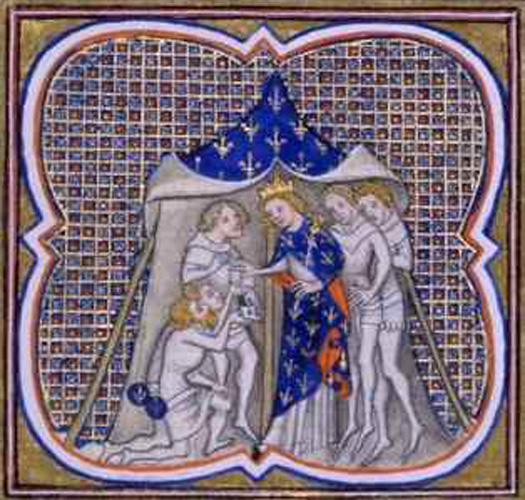 Charles 'the Fat' (not necessarily living up to his descriptive sobriquet) welcomes messengers into his tent as titular head of the Frankish empire, as depicted in the fourteenth century Grandes Chroniques de France Charles 'the Fat' (not necessarily living up to his descriptive sobriquet) welcomes messengers into his tent as titular head of the Frankish empire, as depicted in the fourteenth century Grandes Chroniques de France |
|
| 887 |
Charles 'the Fat' is deposed by the Germans at the Diet of Tribur (November 887) and theFrankish Empire is officially divided between East and West. The western section becomes[France](FranceFranks.htm#Western Franks), while the eastern section becomes the Germanic Roman Empire (modern Germany). Berengar of Friuli is acclaimed king of Italy (perhaps by himself). |
|
|
|
|
| Frankish Kings of Italy AD 888 - 961 Emperor Charles III was deposed by the Germans at the Diet of Tribur (November 887), and the Frankish Empire was officially divided between East and West. Italy was heavily involved in this momentous shift in power, and it certainly did not remain unaffected. Berengar of Friuli claimed the throne in Italy, but Guy of Spoleto was a major rival. Guy failed in his attempt to gain overlordship of the[Western Franks](FranceFranks.htm#Western Franks), and now wanted the Eastern Frankish throne. They engaged in battle near Brescia in 888 and Berengar emerged as marginal victor, albeit with casualties large enough to force him to sue for a peace that lasted until 889. Arnulf of Germany immediately forced Berengar to accept vassal status under him, but it seems that Berengar held the Germanic imperial title. This dual claim to Germany and Italy set a precedent that became the norm, becoming entrenched over the next century. It frequently gave the Germanic emperors domination over northern Italy which was the cause of much later strife. |
|
|
| 888 - 889 |
Berengar I of Friuli |
King of Italy & Germanic Roman Emperor. |
| 889 |
With the truce having expired, Guy of Spoleto attacks Berengar at the Battle of the Trebbia. This time Guy is successful and he assumes the Italian throne, while Berengar is reduced to his own north-eastern Italian holdings in the march territory of Friuli. Despite many attempts, Berengar is unable to retake Italy. 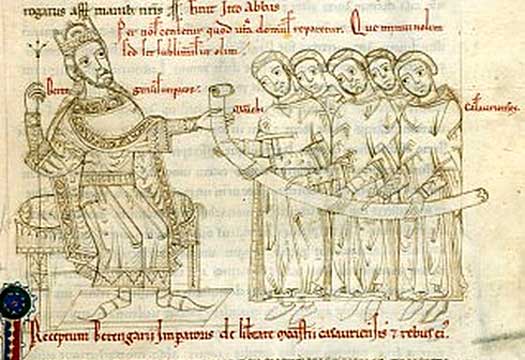 The determined Berengar of Friuli not only controlled the march territory between Italy proper and the Avars and Magyars to the east, but also claimed the Italian throne no less than three times during his eventful life The determined Berengar of Friuli not only controlled the march territory between Italy proper and the Avars and Magyars to the east, but also claimed the Italian throne no less than three times during his eventful life |
|
| 889 - 894 |
Guy / Guido / Wido |
Duke Guy III of Spoleto.Germanic Roman Emperor. |
| 894 - 896 |
Arnulf ofCarinthia, king of Germany, teams up with Berengar and takes Milan and Pavia, while Guy is succeeded on the Italian throne by his son, Lambert. Arnulf leaves his son, Ratold, in command of his captured territory in Italy, forming a dual kingdom in the peninsula. Rule of northern and central Italy is divided between Spoleto and Germany, but Ratold soon departs for Germany, leaving Berengar in command of his section. |
|
| 894 - 896 |
Lambert |
Duke Lambert II of Spoleto.Germanic Roman Emperor. |
| 894 - 896 |
Arnulf of Carinthia |
King of Germany and ruler of Italy in opposition to Lambert. |
| 894 |
Ratold |
Son of Arnulf and vassal. Rival ruler of Milan & Pavia. |
| 894 - 896 |
Berengar I of Friuli |
Vassal of Arnulf. Restored as rival ruler of Milan & Pavia. |
| 896 |
Berengar agrees on the formal division of Italy with Germanic Roman Emperor Lambert. Berengar controls the eastern section, covering the Adda to the Po, while Bergamo is shared. Lambert agrees to marry Berengar's daughter to seal the deal. The peace quickly falls apart when Berengar, perhaps retaining illusions of imperial greatness, is defeated by Lambert while advancing on Pavia. Fortunately for him, Lambert dies just days later. Berengar immediately secures Pavia and is established as sole ruler of Italy (although he is still a vassal of Arnulf, king of Germany, duke of Carinthia, and now Germanic Roman emperor himself). |
|
| 896 - 900 |
Berengar I of Friuli |
Restored as sole ruler of Italy. |
| 899 - 901 |
As part of their initial invasion of Europe, theMagyars invade Italy, possibly at the prompting of Arnulf, king of Germany. Berengar refuses a request by them for an armistice but his army is surprised and routed at the Battle of the Brenta on 24 September 899. The nobility immediately fear that he is unable to defend Italy and they call in Louis of Provence, yet anotherCarolingian descendant. Louis defeats Berengar in 900 and the following year he is crowned Germanic Roman Emperor byPope Benedict IV. |
|
| 900 - 905 |
Louis III of Lower Burgundy & Provence |
King of[Burgundy](FranceBurgundy.htm#Frankish Kingdom of Burgundy) (887-928). Provence (c.891).Emperor (901-905). |
| 905 |
Berengar defeats Louis at Verona, capturing him in the process. Louis is blinded before being allowed to return to Provence, where he remains on the throne as Louis the Blind. Berengar rules Italy again, almost entirely unchallenged, with a heavily fortified Verona as his seat of power. |
|
| 905 - 922 |
Berengar I of Friuli |
Restored again. Germanic Roman Emperor (915-922). |
| 915 |
As the latest in a series of conflicts with the Saracens, the forces of the newEastern Roman strategos of Bari, one Nicolaus Picingli, assemble alongside those of various other southern Italian princes in the Christian League. It includes Landulf I of Benevento, John I and Docibilis II of Gaeta, Gregory IV and John II ofNaples,Pope John X, Guaimar II of Salerno, and Alberic I of Spoleto. The allied Byzantine-Lombard army fights and defeats the Fatamids at the Battle of Garigliano, a drawn-out combination of fights and a siege. The Saracens find themselves in a worsening situation and eventually attempt to flee, only to be captured and killed. It is a militarily significant victory in the fight against Islamic advances in Italy. |
|
| 921 - 923 |
Segments of the Italian nobility are unhappy with Berengar, so they invite Rudolph II of Upper[Burgundy](FranceBurgundy.htm#Frankish Kingdom of Burgundy) to take the throne. At the same time, Berengar's own grandson, Berengar of Ivrea, is encouraged by Rudolph to rise against him. Berengar retreats to Verona and watches helpless as Italy is ravished by invadingMagyars, their attacks the trigger for a change of leadership in Italy in the first place. Rudolph's forces unite with those of Berengar of Ivrea and defeat those of Berengar of Friuli at the Battle of Fiorenzuola on 29 July 923. Berengar is soon murdered at Verona by one of his own men. Rudolf rules Italy and also holds the title of Germanic Roman Emperor, only to find a rival in Hugh of Arles. |
|
| 922 - 926 |
Rudolf II of Upper Burgundy |
King of[Burgundy](FranceBurgundy.htm#Frankish Kingdom of Burgundy) (912), Lower Burgundy (933) &Emperor (922). |
| 926 - 947 |
Hugh of Arles |
King of[Burgundy](FranceBurgundy.htm#Frankish Kingdom of Burgundy) (928-933) &Emperor (933). |
| 933 |
Provence (Lower Burgundy) ceases to be a separate kingdom when Hugh of Arles, king of[ Burgundy](FranceBurgundy.htm#Frankish Kingdom of Burgundy), exchanges that with Rudolph II of Upper Burgundy for the crown of Lombardy, otherwise known as the kingdom of Italy. The exchange ends Rudolf's claim on Italy once and for all. |
|
| 937 |
A massive invasion is conducted by theMagyars as they sweep around in a giant circle through central and Southern Europe. They begin from their base in Pannonia to enter into and ravage[ Bavaria](GermanyBavarians.htm#Duchy of Bavaria %28Welfs%29), [ Swabia](GermanySwabia.htm#Dukes of Swabia),Saxony,Franconia, andThuringia within theEast Frankish kingdom. From the Aachen area, the Magyars advance deep into the [West Frankish](FranceFranks.htm#Western Franks) kingdom, the kingdom of Provence, and then the territory of the Middle (Italian) Franks. They attack Tuscany and the Papal States as far south as Naples, before returning to their adopted Hungarian homeland. |
|
| 945 |
An uprising of the Italian nobility forces Hugh into exile, and Berengar of Ivrea now holds any true power and patronage. Hugh's successor is Lothar II, his own son, but he exercises no authority in Italy, quickly dying at Turin. It is possible that he is poisoned by Berengar of Ivrea who subsequently formalises his control of Italy by claiming the throne. |
|
| 947 - 950 |
Lothar II / Lothair of Arles |
Germanic Roman Emperor. |
| 950 - 961 |
Berengar II of Ivrea |
Germanic Roman Emperor. Margrave of Ivrea & Corsica. |
| 950 - 961 |
Adalbert II |
Son and joint ruler. |
| 953 |
Feeling that his position is threatened by the marriage of his father, Otto of Saxony, to Adelaide, heiress of Italy, Ludolph of[Swabia](GermanySwabia.htm#Dukes of Swabia) joins forces with his brother-in-law, Conrad the Red, duke ofLorraine, in revolt. Ludolph is supported by the Swabians, but Conrad fails to gain the same support from his own subjects. Otto and Henry I of[ Bavaria](GermanyBavarians.htm#Duchy of Bavaria %28Welfs%29) defeat the rebellion. The following year, Ludolph is deprived of his title. |
|
| 961 |
 Berengar is defeated by the Saxon king of Germany, Otto I and imperial control is subsequently restored on Corsica (by 965). Italy is officially incorporated into theHoly Roman empire. Berengar is defeated by the Saxon king of Germany, Otto I and imperial control is subsequently restored on Corsica (by 965). Italy is officially incorporated into theHoly Roman empire. 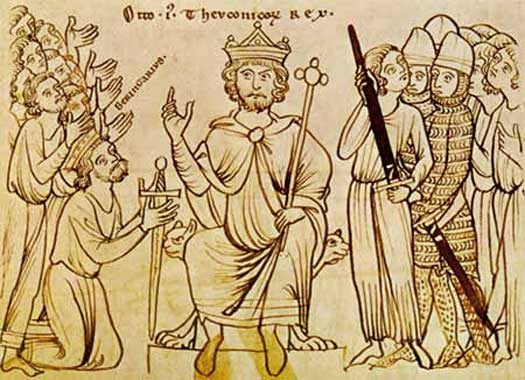 Otto accepts the surrender of Berengar of Ivrea in 961 to become undisputed German emperor, shown in this early thirteenth century text called the Manuscriptum Medioalense Otto accepts the surrender of Berengar of Ivrea in 961 to become undisputed German emperor, shown in this early thirteenth century text called the Manuscriptum Medioalense |
|
| 961 - 973 |
Otto I the Great |
Duke ofSaxony (936-973) and Holy Roman Emperor. |
| 973 - 1158 |
With the rise to power of theSaxon Otto I, control of Italy falls permanently to the non-Frankish Holy Roman Emperors. The precedent that had been established in 888 is now firm fact, and Italy does not have a dominant leader of its own to challenge imperial control. Instead, Italian politics remains a maze of in-fighting between a patchwork of city states, various duchies and margraviates (such as Benevento, Camerino, Capua, and Spoleto), and the Papal States. |
|
| 1158 - 1162 |
Supported as always by his brother-in-law, Louis the Iron ofThuringia,Holy Roman Emperor Frederick I claims direct imperial control of Italy at the Diet of Roncaglia in 1158. The diet, held near Piacenza, includes representatives of cities in northern Italy, plus general nobles and senior church officials of the empire. It is held as a direct response to raids carried out by Frederick Barbarossa in Italy, who is attempting to restore his rights over the increasingly independent trading cities there. The diet finds in his favour so the cities of northern Italy refuse to accept the decision. Frederick imposes his will by force of arms, and in 1162 razes Milan to the ground (supported on campaign by Herman ofCarinthia). The Italian response is to unite under the[Lombard League](#Lombard League). |
|
|
|
|
| Lombard League of Italy c.AD 1167 - 1250 With Holy Roman Emperor Frederick I forcibly attempting to increase his influence in, and power over, Italy, the Lombard League was formed around the year 1167. Its job was to counter the imperial threat, and it was bolstered by the support of the Papacy, which was just as keen to reduce imperial interference in 'its' sphere of influence. At its height it managed to incorporate most of the cities of northern Italy, including Bergamo, Bologna, Brescia, Crema, Cremona, Genoa, Lodi, Mantua, Modena, [Milan](#Lords of Milan), Padua, Parma, Piacenza, Reggio Emilia, Treviso, Venice, Vercelli, Verona, and Vicenza. The exact make-up of the league changed over time, with some cities seceding and others joining. Once the league had achieved its aims in 1176 and 1183 it was no longer needed. But subsequent events, especially when Emperor Frederick II attempted to reverse the defeat of 1176, meant that it was reformed several times. In fact, both Fredericks were the league's greatest reason to exist. Once the second of them had died, the league was dissolved, its job successfully done. Much of it was absorbed into the territory of Milan. |
|
|
| 1167 |
Almost as soon as it is founded, the Lombard League becomes the 'last man standing' in the fight against Holy Roman Emperor Frederick I. His defeat of Pope Alexander III at the Battle of Monte Porzio knocks the Papal States out of the conflict, but the Pope continues to support the Lombard League quite heavily. |
|
| 1176 |
The struggle between Holy Roman Emperor Frederick I and the Lombard League comes to a head at the Battle of Legnano on 29 May 1176. Frederick is heavily defeated, with his personal guard being slain and he himself being thrown from his horse, whereupon his troops believe him to have been killed. The subsequent Peace of Venice agrees a six-year truce which is concluded by the Peace of Constance. 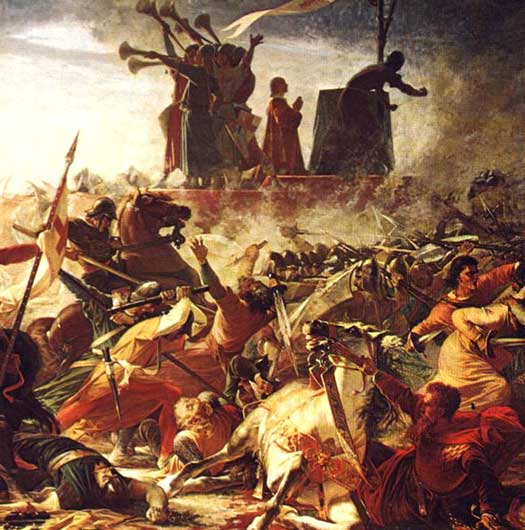 The Battle of Legnano on 29 May 1176 ended the hopes of Holy Roman Emperor Frederick Barbarossa of dominating Italy following his defeat by the Lombard League The Battle of Legnano on 29 May 1176 ended the hopes of Holy Roman Emperor Frederick Barbarossa of dominating Italy following his defeat by the Lombard League |
|
| 1183 |
Milan becomes a self-governing imperial city thanks to the Peace of Constance, in which Frederick I is forced to renounce his rights of sovereignty over northern Italy. The Italian cities agree to remain loyal to theHoly Roman empire but will pursue an independent course when it comes to their own governance. Although Milan is a republic it is usually dominated by one person, a so-called signore. The city quickly becomes dominated by the della Torre, who establish themselves as lords of [Milan](#Lords of Milan). |
|
|
|
|
| Lords of Milan AD 1240 - 1395 Pagano della Torre (meaning 'of the tower' and also rendered as Torriani) was a condottiero, essentially a military leader with the status of a warlord, someone who often served as a mercenary commander in times of conflict in Italy. His grandfather was one Martino 'The Giant' who fought in the Crusades. Martino's son was Jacopo, who married into the powerful Visconti family and became captain of Milan while his in-laws were serving as patrician of Pisa, dominating the giudici of Cagliari, and intermarrying with the giudici of Gallura. Pagano was Jacopo's son, and he also became captain of Milan (in 1240), establishing himself and his descendants as the main power in the city. Milan had been founded by the Celtic Insubres tribe, perhaps around 600 BC. It was developed under Roman control, but its convoluted political history during the medieval period essentially reflected that of all of Italy. The governance of the peninsula was disjointed and fractured, with frequent internecine squabbles and threats from greater powers from outside Italy, especially from the growing might of France, Aragon, and Castile. All of northern Italy remained nominally under the vassalage of theHoly Roman empire, but the struggle for power between the Papist Guelfs and their opponents, the Imperialist Ghibellines, was intense in this period. |
|
|
| 1240 - 1247 |
Paganus / Pagano I della Torre |
Son of Jacopo. Captain of Milan. Died. |
| 1247 - 1257 |
Paganus / Pagano II della Torre |
|
| 1253 - 1256 |
Manfredi Lancia |
|
| 1257 - 1259 |
Martino della Torre |
Brother or nephew of Pagano I. Died 1263. |
| 1257 - 1259 |
Martino imposes his personal power over Milan as its captain. The della Torre lordship of the city begins with him and lasts for half a century or so. The della Torre family also hold Bergamo, Lodi, Novara, and Vercelli. In 1259, Oberto Pallavicino, a field captain for formerHoly Roman Emperor Frederick II, defeats the Lombardic-Guelphish League of towns at the Battle of Cassano, and as a reward he is granted command of Alessandria, Como, Lodi, Milan, Novara, and Tortona. 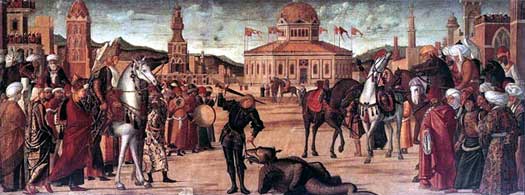 Medieval Italy was a cauldron of competing city states, with unceasing competition between them that sparked the Renaissance and a blossoming of culture and advancement Medieval Italy was a cauldron of competing city states, with unceasing competition between them that sparked the Renaissance and a blossoming of culture and advancement |
|
| 1259 - 1264 |
Oberto Pallavicino |
|
| 1263 - 1265 |
Filippo della Torre |
Brother of Martino. |
| 1265 - 1277 |
Napoleone della Torre |
Cousin, and son of Pagano I. Imprisoned, died the following year. |
| 1273 - 1274 |
With his brother Raimondo, bishop of Como, having been a prisoner of Conrad Venosta von Matsch (a minor vassal from the alpine Valchiavenna region of Lombardy) since 1269, Napoleone manages to free him. In the same year, Rudolph of Habsburg is elected Holy Roman Emperor and Napoleone switches his own allegiance to him, away from the now too-dominant Charles of Anjou inNaples. As a reward, in 1274 Napoleone is granted the title of imperial vicar in Lombardy. |
|
| 1277 |
Napoleone is attacked by Ottone Visconti in a struggle for control of Milan. Initially, Napoleone holds him off, winning the Battle of Guazzera (the captured nephew of Ottone Visconti, Teobaldo Visconti, is captured during the battle and is later beheaded). However, he is subsequently defeated at the Battle of Desio, and della Torre power in Milan is broken, barring a brief final flourish in 1302. Napoleone dies the following year. Francesco della Torre, podestà of Alessandria, Bergamo, Brescia, Lodi and Novara, is also killed by the visconti at Desio, a double blow for the della Torre family. |
|
| 1277 - 1294 |
Ottone Visconti |
Son of Ubaldo Visconti. Archbishop of Milan. |
| 1284 |
Early in the year, Genoa attempts the conquest of Porto Torres and Sassari on Sardinia (part of the recently fallen giudicato ofLogudoro). Part of Genoa's large merchant fleet defeats a Pisan force while heading into the eastern Mediterranean. Then Genoa blockades Porto Pisano, Pisa's own harbour, and attacks Pisan vessels across the Mediterranean. The final act is the Battle of Meloria on 5-6 August 1284, close to Livorno on Italy's upper western coast. The Pisan fleet is decimated by Genoese galleys at the same time as Pisa itself is attacked by Florence and Lucca, destroying any hope of a Pisan restoration. The defeat marks the end of Pisa as a major power, sending the city into a decline that ends with its eventual conquest by Florence.Corsica is ruled by the victorious Genoa. |
|
| 1294 - 1302 |
Matteo I Visconti |
Grand-nephew through Teobaldo Visconti (killed 1277). |
| 1288/1291 |
Holy Roman Emperor Rudolph I appoints Matteo as his vicar general for Lombardy, and the captain's influence extends as far as Bologna, Emilia, Genoa, and Piedmont. The year in which this takes place is unclear, either being 1288 or 1291. |
|
| 1297 - 1302 |
Lugano is taken from the bishopric of Como and becomes the property of Milan. The struggle for power in Italy between the Papist Guelfs, which in Rome are led by the Orsini family, and their opponents, theImperialist Ghibellines which are led by the Colonna family, is intense in this period. It also influences the struggle for power between Como and Milan. When Guido della Torre of the anti-Visconti Guelfs displaces Matteo Visconti as lord of Milan in 1302, Como regains Lugano and holds it for over a century. |
|
| 1302 - 1311 |
Guido della Torre |
Fled Milan and died in 1312. |
| 1308 |
With the death of Nino Visconti, giudice of Gallura, his daughter Joanna inherits the title. Despite attempts to assert her rights to control Gallura, she is unsuccessful, and she eventually sells her title to her relatives, the Visconti family of Milan (presumably in 1308). They later sell them on toAragon, which is eventually able to conquer the entire island of Sardinia. |
|
| 1311 |
Guido attempts to rally the people of Milan againstHoly Roman Emperor Henry VII of Luxemburg and his proposed treaty between the opposing factions in Italy. The attempt fails and Guido is forced to flee Milan, to be replaced by the restored Matteo Visconti. |
|
| 1311 - 1322 |
Matteo I Visconti |
Restored. Abdicated. |
| 1320 - 1322 |
In an escalation of the continuing conflict between Guelfs and Ghibellines, [Pope](ItalyPopes.htm#Great Schism) John XXII ensures that Matteo is charged with necromancy for attempted papicide. Matteo refuses to appear before the papal court and is found guilty in his absence in 1321. The charge spreads to Galeazzo, Matteo's son, and in 1322 the papal legate, Cardinal Bertrand du Poujet, proclaims a holy crusade against the Visconti. With the stakes escalating further, Matteo stands aside in favour of his son (and dies a month later). |
|
| 1322 - 1327 |
Galeazzo I Visconti |
Son. Imprisoned at Monza. |
| 1327 - 1339 |
Azzone Visconti |
Son. Died of gout. |
| 1330 |
In a change to the established tradition, Azzone is named perpetual lord of Milan, now that the threat of excommunication raised against his family during the conflict with Matteo Visconti has expired. |
|
| 1331 - 1335 |
Azzone allies himself with Theodore I, marquess of Montferrat. Their common enemy is Robert of Anjou, king ofNaples, and Azzone is keen to reclaim his possessions in north-western Italy. The following year, he takes Bergamo and Pizzighettone. Further conquests in 1335 include Crema, Cremona, Lodi, and Vercelli, along with other territories in Lombardy that had ceded control to the [ Papal States](ItalyPopes.htm#Great Schism). |
|
| 1339 - 1349 |
Luchino Visconti |
Brother of Galeazzo I. Lord of Pavia (1315). Poisoned. |
| 1339 - 1349 |
Luchino expands his territory during his time as lord of Milan, by hiring an army of mercenaries and placing them under the command of his illegitimate son, Stefano. Pisa is captured, and Parma is purchased from Obizzo III d'Este, marquis of Ferrara. |
|
| 1343 - 1345 |
Jani Beg, khan of theGolden Horde, leads a massive Crimean Tartar force against the Crimean port city of Kaffa. The assault turns into a siege which is lifted by a Genoese relief force. Two years later, Jani Beg returns, but the second attack against Kaffa is defeated by an outbreak of Black Plague. There is a possibility that Jani Beg's army catapult their infected fellow troops into Kaffa so that the defenders will become infected. The ploy fails to bring the city to its knees, but infected Genoese sailors subsequently take the Black Death with them back to Italy. |
|
| 1349 - 1354 |
Giovanni Visconti |
Brother. Archbishop of Milan (1342-1354). |
| 1350 - 1352 |
Giovanni secures control of Bologna as its new lord, and he places his nephew, Bernabò, in command there. Milan continues to increase its power in Lombardy in general. Genoa is added to the list of Milanese possessions in 1352, with Giovanni becoming lord there, and in 1353 Novara is also acquired. |
|
| 1354 - 1385 |
Bernabò Visconti |
Nephew, and son of Stefano. |
| 1354 - 1378 |
Galeazzo II Visconti |
Brother and co-ruler. |
| 1354 - 1355 |
Matteo II Visconti |
Brother and co-ruler. |
| 1355 |
After having shared power in turns in Milan for just a year, the vicious Matteo is murdered by his two brothers, and they divide his share of Milan's outer territories between themselves. 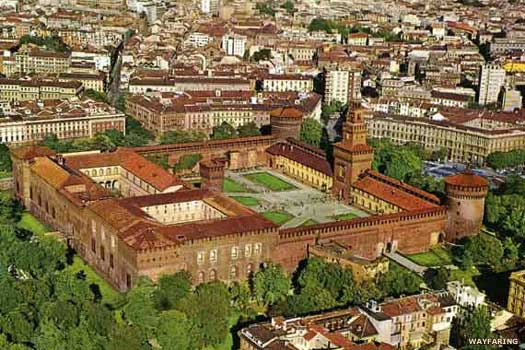 Although Sforzesco Castle was only transformed into a ducal palace by its namesake, Francesco Sforza, in 1450, its origins date to the time of Galeazzo II Visconti Although Sforzesco Castle was only transformed into a ducal palace by its namesake, Francesco Sforza, in 1450, its origins date to the time of Galeazzo II Visconti |
|
| 1378 - 1385 |
Gian Galeazzo I Visconti |
Son of Galeazzo II, and co-ruler with Bernabò Visconti. |
| 1385 |
Bernabò Visconti is overthrown by his nephew and son-in-law, Comte de Vertus in Champagne, Gian Visconti (a title delivered to Gian by his first wife, Isabelle of Valois). Bernabò is imprisoned and dies soon afterwards, poisoned allegedly on Gian's orders. Soon after securing his new domain, Gian expands his territory. He seizes Padua, Verona, and Vicenza, becoming lord of each of them and giving himself control of much of the Po Valley. Padua is lost in 1390. |
|
| 1385 - 1395 |
Gian Galeazzo I Visconti |
Became sole lord in 1385. Raised to duke of[Milan](#Duchy of Milan). |
| 1395 |
Gian Galeazzo Visconti purchases a diploma for 100,000 florins from Holy Roman Emperor Wenceslas ofLuxemburg. This diploma confirms Gian Visconti as duke of[Milan](#Duchy of Milan) and count of Pavia. |
|
|
|
|
| Duchy of Milan AD 1395 - 1535 The duchy of Milan constituted twenty-six towns in central-northern Italy when it was created on 1 May 1395 by Gian Galeazzo Visconti, lord of [Milan](#Lords of Milan). Ultimately, the towns were possessions of the Holy Roman empire, and the duchy remained a vassal of the empire. It was located to the north and south of the River Po, and extended westwards to the Montferrat hills and eastwards to the Venetian Lagoon. It was neighboured by theSwiss to the north,Venice and Mantua to the east, Modena and Genoa to the south, and Montferrat andSavoy to the west. Milan had developed from the Roman town of Mediolanum (the scene of a battle between Emperor Gallienus and the Alemanni in AD 259). Serving for a time as the capital of the Western Roman empire (until 402), it was captured by the invadingLombards in 569, and in 661 it formed the capital of a briefly divided Lombard kingdom. It remained a vital city despite not always being a seat of power, and its recreation at the heart of the duchy gave it all of the towns of the former Lombard League. |
|
|
| 1395 - 1402 |
Gian Galeazzo I Visconti |
Former lord of [ Milan](#Lords of Milan) who purchased the duchy. |
| 1402 |
Dreaming of a united Italy under his control, Gian Visconti launches ill-advised assaults against his main obstacles, Bologna and Florence. Although his forces are generally expected to succeed, losses are heavy on all sides. Victory at the Battle of Casalecchio on 26 June sees the Bolognese defeated, but Gian succumbs to fever at Melegnano Castle on 10 August and dies a month later. His combined territories break up amid squabbling between his heirs. 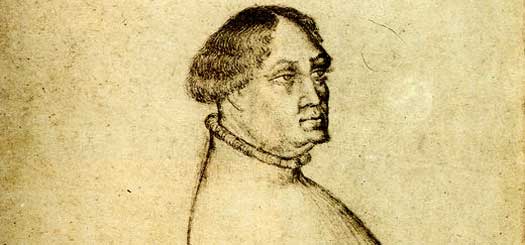 A portrait of Gian Galeazzo I Visconti, first duke of Milan during the politically troubled early Renaissance period in Italy in which he was able to purchase his title and domains A portrait of Gian Galeazzo I Visconti, first duke of Milan during the politically troubled early Renaissance period in Italy in which he was able to purchase his title and domains |
|
| 1402 - 1412 |
Gian Maria Visconti |
Son. Aged 13 upon accession. Assassinated. |
| 1402 - 1404 |
Catarina Visconti |
Mother and regent. Arrested and murdered. |
| 1404 |
Condottiero Facino Cane, a military leader with the status of a warlord, poisons Gian Maria's mind against his mother, Catarina Visconti. The young duke has her arrested on suspicion of treason and imprisons her in Monza Castle, were she is apparently poisoned in the same year. |
|
| 1411 - 1416 |
Lugano is again under Milan's administration, until it is regained by the bishopric of Como for the second and last time (the first time being in 1297). |
|
| 1412 - 1447 |
Filippo I Maria Visconti |
Brother. Died without issue. |
| 1421 - 1435 |
Following a period of French domination of the republic of Genoa, Filippo Visconti manages to dominate it for a little over a decade. In the same year, 1421, his condottiero, Francesco Bussone, count of Carmagnola, conquers Brescia for him. |
|
| 1423 - 1427 |
When Giorgio Ordelaffi, lord of Forl�, dies, his son succeeds him although he is still a child. Filippo Visconti becomes his guardian but abuses his position of trust and attempts to conquer areas of the Romagna in 1423. The republic of Florence refuses to allow Milan's unchecked expansion of territory, so the Wars in Lombardy are triggered.Venice is soon persuaded to join in 1425, on the side of Florence. In March 1426 Francesco Bussone foments riots in Brescia, beginning the process by which Venice conquers it after a long campaign, expanding its Dry Land Dominion in the process. Filippo is forced to accept a peace deal proposed by Pope Martin V which favours Venice and Francesco Bussone. At the first opportunity, Filippo resumes the fighting but is quickly defeated at Maclodio on 12 October 1427. A more concrete peace is signed at Ferrara. |
|
| 1428 - 1437 |
Filippo manages to occupy Monaco as part of its domination of Genoa. Monaco's ruling lord, Jean I, regains control in 1436 and prompty heads off to fight in the Wars in Lombardy. During his absence his wife, Pomellina Fregoso, acts as regent and successfully defends the lordship against aSavoyard siege. |
|
| 1434 |
The duke of Milan secures Lugano permanently, but now with the counts of[Lugano](ItalyLugano.htm#Lugano %28Sanseverino%29) providing regional control. The dispossessed Rusca family is compensated with the ownership of Locarno. |
|
| 1437 - 1441 |
Filippo Maria Visconti captures Jean I ofMonaco in 1437 and repeatedly attempts to persuade him to turn over his lordship to Milan. Jean refuses so, in 1438, Filippo hands Jean to Louis, duke of Savoy. Filippo also agrees to annexe Monaco to Savoy, but Jean does not cooperate. Pomellina gains Jean's release in 1441. |
|
| 1438 |
The bridge over the River Tresa, approximately nine kilometres to the south-west of [Lugano](ItalyLugano.htm#Lugano %28Sanseverino%29), has been mentioned in records since the ninth century. The area on either side of the bridge contains the villages of Lavena and Ponte Tresa (both of which had originally been settled by the Ligurians and Celts and which bear Celtic names). More recently, this area has been fought over by Como and Milan, part of their incessant rivalry for domination in northern Italy. Now the Visconti duke of Milan gives the villages to Count Luigi of Lugano. |
|
| 1440 |
Filippo Visconti's troops, led by his condottiero, Francesco Piccinino, fight the Battle of Anghiari on 29 June 1440 against the Italian League which is led by the republic of Florence. The battle is part of the Wars in Lombardy, during which the five major Italian powers cement the positions they will hold until the Italian Wars start in 1494. The Milanese forces are defeated, despite holding numerical superiority. |
|
| 1447 - 1450 |
Upon the death of Filippo Visconti, the last direct male representative of his family, the Golden Ambrosian republic is declared in Milan on 13 August 1447. Members of the University of Pavia are the driving force behind the declaration, but they find able support from Francesco Sforza, a condottiero and an adventurer who is married to the illegitimate daughter of Filippo Visconti. Sforza is able to help defend the duchy from multiple claimants to the title, including the French duke of Orleans, and attacks by mightyVenice, although Crema is lost to the Venetians. Ultimately, Francesco betrays the Ambrosian republic, seizes Milan, and pronounces himself the new duke on 25 March 1450. |
|
| 1450 - 1466 |
Francesco I Sforza |
m daughter of Filippo Maria. Probable count of[Lugano](ItalyLugano.htm#Lugano %28Sanseverino%29) in 1464. |
| 1461 - 1464 |
Having abandoned his long-standing support of the Angevins in their claim ofNaples, Francesco Sforza takes advantage of a revolt in Angevin Genoa. He ensures the election of a puppet there in the form of Spinetto Campofregoso, and manages to retain control of Genoa and Savona until the formation of the emergency government and the 'Eight Defenders of the Fatherland'. |
|
| 1466 - 1476 |
Galeazzo III Maria Sforza |
Son. Assassinated. |
| 1466 - 1468 |
Bianca Maria Visconti |
Mother and co-ruler. Edged out of power by her ruthless son. |
| 1476 - 1494 |
Gian Galeazzo II Sforza |
Son. Acceded aged 7. Died under suspicious circumstances. |
| 1476 - 1481 |
Bona of Savoy |
Mother and regent. Edged out of power by Ludovico Sforza. |
| 1477 |
The son of the late Duke Francesco and his wife, Bianca Maria, Ottaviano opposes the restoration of Ugo Sanseverino as count of [Lugano](ItalyLugano.htm#Lugano %28Non-Dynastic%29). Supposedly this is for two years, but the nineteen year-old Ottaviano Maria Sforza drowns near Rivolta d'Adda in 1477 while attempting to escape arrest. He has no issue, so his claim to the county passes to one of his brothers. 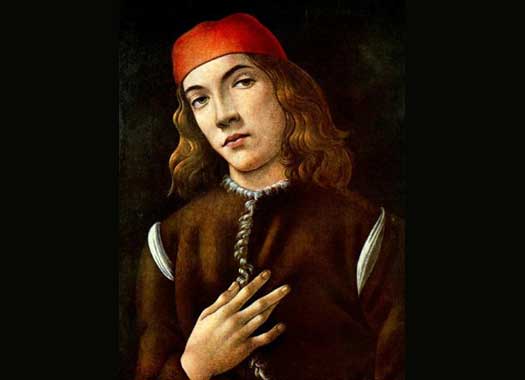 The ill-fated Ottaviano Maria Sforza, who opposed the restoration of Ugo, count of Lugano, and soon afterwards was drowned while attempting to avoid arrest, was painted in oils by Botticelli The ill-fated Ottaviano Maria Sforza, who opposed the restoration of Ugo, count of Lugano, and soon afterwards was drowned while attempting to avoid arrest, was painted in oils by Botticelli |
|
| 1481 |
Bona of Savoy has until now acted as regent for her young son. However, she has been engaged in a protracted and bitter struggle for power with her brother-in-law, Ludovico Maria Sforza and, despite the best attempts of everyone involved to keep Ludovico out of power, he now seizes control of Milan's government. The remainder of the lifetime of Duke Gian Galeazzo II (which is terminated in suspicious circumstances) sees Ludovico in full command of Milan as his regent. |
|
| 1481 - 1494 |
Ludovico Maria Sforza |
Son of Francesco. Regent. Count of[Lugano](ItalyLugano.htm#Lugano %28Non-Dynastic%29) (1484-1501). |
| 1488 - 1499 |
Milan briefly controls Genoa again but is initially rebuffed by the Genoese emergency government. However, Milan dominates the republic until France intervenes. |
|
| 1494 - 1499 |
Ludovico Maria Sforza / Louis / Ludwig |
Former 'regent' and de facto ruler since 1481. |
| 1494 - 1495 |
The county of [ Holland](FranceHolland.htm#House of Habsburg) passes to the son of Holy Roman Emperor Maximilian and Mary of Burgundy. That son is Philip, later king consort ofCastile. The following year, an alliance is formed between Naples, thePope, Milan, Venice, and the emperor in order to defend Italy from Charles VIII of France. This marks the beginning of the highly destructive Italian Wars which last until 1559. |
|
| 1498 - 1499 |
The duke of Orleans succeeds to the French throne as Louis XII, and immediately seeks to enforce his father's claim on Milan. He invades in 1499, also taking control of [Lugano](ItalyLugano.htm#Lugano %28Non-Dynastic%29), and Ludovico Sforza is soon ousted. The seizure of Lugano serves to end a period of rebellions and uprisings that have been taking place against the dukes of Milan. It also introduces a new dynamic in the perpetual struggles between Como and Milan, with the Swiss Confederation now also becoming involved. |
|
| 1499 - 1500 |
Louis XII of France |
Grandson of Valentina, daughter of Gian Galeazzo Visconti. |
| 1500 |
Ludovico Sforza |
Restored. Died 1508. |
| 1500 |
Ludovico manages to regain Milan by returning with an army of mercenaries, which includes Swiss fighters. He uses the city of Novara as his base, and Louis XII quickly lays siege to it. With Swiss troops on both sides, those fighting for Ludovico decide to absent themselves from the battle rather than fight their fellow countrymen. The 'Betrayal of Novara' sees Ludovico being handed over to the French, who promptly transport him to a dungeon at Loches where he remains for the rest of his life. The duchy is now France's on the basis of the claim by Louis XII. |
|
| 1500 - 1512 |
Louis XII of France |
Restored. Ousted by the Swiss. |
| 1503 - 1513 |
[Lugano](ItalyLugano.htm#Lugano %28Non-Dynastic%29) is occupied by the duchy of Milan for just a decade, before becoming the property of Switzerland, this time permanently. The Swiss also oust the French from Milan, and Massimiliano Sforza is raised to the title of duke. |
|
| 1512 - 1515 |
Massimiliano Sforza |
Son of Ludovico. |
| 1515 |
The French invade again, this time under Francis I. Victorious at the Battle of Marignano, they capture and imprison Massimiliano, and Francis I personally assumes the title of duke. The French have various allies assisting them, including Duke Anthony the Good of [Lorraine](FranceLorraine.htm#Duchy 2). |
|
| 1515 - 1521 |
Francis I of France |
Son-in-law and cousin of Louis XII ofFrance. |
| 1521 |
The French are again driven out of Milan, now by the[Austrians](GermanyAustria.htm#Habsburg Archdukes) under Holy Roman Emperor Charles V who installs Massimiliano's younger brother, Francesco II Sforza. His brief tenure is ended, again by a French occupation (although seemingly without Anthony of [ Lorraine](FranceLorraine.htm#Duchy 2) who has returned home). |
|
| 1521 - 1524 |
Francesco Maria II Sforza |
Brother of Massimiliano. |
| 1524 - 1525 |
Francis I of France |
Restored. |
| 1525 |
The French are defeated at the Battle of Pavia, leaving Holy Roman Emperor Charles V dominant in Italy. Newly re-installed Duke Francesco Sforza joins the League of Cognac against the emperor along with Florence, France, the [Pope](ItalyPopes.htm#Early Modern), andVenice. This backfires when the emperor takes military action against Milan. |
|
| 1525 - 1535 |
Francesco II Sforza |
Restored. Died without issue. |
| 1529 |
Francesco is driven out of Milan by Holy Roman Emperor Charles V, but he retains control of other towns within the duchy, and is restored in Milan following the peace accord of Cambrai in the same year. |
|
| 1535 |
Giovanni Paolo Sforza |
Half-brother. Laid claim to the duchy but died mysteriously. |
| 1535 |
With Francesco dead and his half-brother also conveniently and abruptly dead following a short-lived claim for the duchy, both France and the Holy Roman Emperor claim Milan for themselves. Emperor Charles V invests his son, Phillip II ofSpain, as the duke of Milan, tying the duchy to Spain for the next century and-a-half. |
|
|
|
|
| Spanish Governors of the Duchy of Milan AD 1535 - 1706 Despite the frequent changes in possession, Milan remained a fief of the Holy Roman Emperor Charles V. Although France held a legitimate claim to the duchy through Louis XII and his Milanese grandmother, Charles V ignored this and instead invested his son, Phillip II ofSpain as the duke of Milan in an attempt to retain as many Habsburg holdings as possible across Europe. It took the French until 1559 and the Treaty of Cateau-Cambrésis before they would recognise Philip as the duke. However, while he held the title of duke directly, he resided in Spain and day-to-day authority within the duchy was handed to a governor. Although Italy did not possess the political cohesiveness to replicate Spain's general expulsion in 1492 of members of the Jewish Diaspora, various anti-Semitic acts were perpetrated in this period. Throughout the century Jews in Italy gradually head north as the south became increasingly inhospitable to them. Then conditions in [Rome](ItalyPopes.htm#Early Modern) worsened after 1556 and in the Venetian republic in the 1580s. |
|
|
| 1535 - 1536 |
Antonio de Leyva |
Prince of Ascoli. Duke of Terranova. Died. |
| 1536 - 1538 |
Cardinal Marino Caracciolo |
Governed civil and economic affairs. Died. |
| 1538 - 1546 |
Alfonso d'Avalos d'Aquino |
Governed military affairs during Caracciolo's term of office. |
| 1545 |
The duchy of Parma is created out of a portion of territory that had belonged to the duchy of Milan - an area to the south of the River Po that is centred around the city of Parma. The new duchy is for [Pope](ItalyPopes.htm#Early Modern) Paul III's illegitimate son, Pier Luigi Farnese. As the duchy's overlord, Holy Roman Emperor Charles V soon invests his own son with the title. 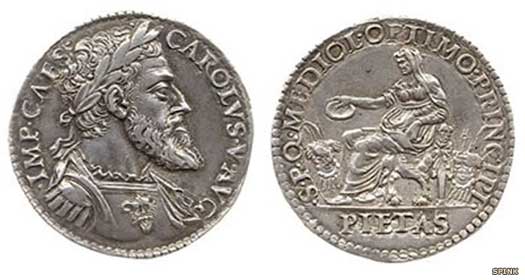 Holy Roman Emperor Charles V is depicted wearing a laurel crown on the obverse of this silver medallic 'testone' which was struck by the duchy of Milan in homage to him Holy Roman Emperor Charles V is depicted wearing a laurel crown on the obverse of this silver medallic 'testone' which was struck by the duchy of Milan in homage to him |
|
| 1546 - 1555 |
Ferrante / Ferdinando Gonzaga |
Prince of Molfetta. Duke of Ariano. |
| 1553 - 1555 |
The Italian War results in an invasion of Corsica in 1553 which disrupts Genoese rule of the island. French and Ottoman forces team up in the Mediterranean to disrupt coastal areas that are loyal to or controlled by theHoly Roman Emperor. The French are the driving force behind these operations in their attempt to gain control of Italy. They raid the coasts of Corsica, Elba, Naples, and [Sicily](ItalySicily.htm#Aragons United). Then a force of French and Ottomans, together with Corsican exiles, capture the strategically important island, robbing the empire of a vital line of communications. Their fleets leave as winter approaches, with a fairly small garrison of 5,000 second line troops remaining behind. Genoa immediately organises a counter-invasion with 15,000 men, and much of Corsica is retaken in 1554, with the rest being gained in 1555. |
|
| 1555 - 1556 |
Fernando Álvarez de Toledo |
Duke of Alba. Governor of the Spanish Netherlands (1567-1573). |
| 1556 - 1557 |
Cristoforo Madruzzo |
Prince-Bishop of Trent (1539-1567). |
| 1558 - 1560 |
Gonzalo II Fernández de Córdoba |
Grandson of Gonzalo Fernández de Córdoba, viceroy ofNaples. |
| 1559 |
The Italian Wars (started 1494) conclude with the signing of the Treaty of Cateau Cambrésis between England, France and Spain. Emmanuel Philibert regains his duchy of Piedmont and Savoy in full as part of the war's ending and he departs his post in the Spanish Netherlands to take up his duties. Corsica is restored to Genoa, while Spain is confirmed in its direct control of Milan, Naples, Presidi,Sardinia, and [Sicily](ItalySicily.htm#Aragons United), now free of any counter-claim by France. |
|
| 1560 - 1563 |
Francesco Ferdinando II d'Ávalos |
Son of Alfonso d'Avalos d'Aquino. Viceroy of[Sicily](ItalySicily.htm#Aragons United) (1568-1571). |
| 1563 - 1564 |
Gonzalo II Fernández de Córdoba |
Second term of office. Duke of Baena. |
| 1564 - 1571 |
Gabriel de la Cueva |
Duke of Alburquerque. Died. |
| 1571 - 1572 |
Álvaro de Sande |
Interim governor. |
| 1572 - 1573 |
Luis de Zúñiga y Requesens |
Brother of Viceroy Juan de Zúñiga y Requesens ofNaples. |
| 1573 |
Luis de Zúñiga is summoned by King Philip II of Spain to become governor of the Spanish Netherlands. Once there he proves to be one of the more restrained and enlightened governors. |
|
| 1573 - 1580 |
Antonio de Zúñiga y Sotomaior |
Died. |
| 1580 - 1583 |
Sancho de Guevara y Padilla |
|
| 1583 - 1592 |
Carlo d'Aragona Tagliavia |
Viceroy of[Sicily](ItalySicily.htm#Aragons United) (1566-68 & 1571-77), & Catalonia (1581-1582). |
| 1592 - 1595 |
Juan Fernández de Velasco |
Duke of Frías. |
| 1595 |
Don Pedro de Padilla |
Interim governor. Governor of Oran & Mazalquivir (1585-89). |
| 1595 - 1600 |
Juan Fernández de Velasco |
Returned to office after defeat toFrance at Fontaine-Française. |
| 1600 - 1610 |
Pedro Enríquez de Acevedo |
Count of Fuentes. ViceroyNaples. Gov Spanish Netherlands. Died. |
| 1600 |
Not long after being replaced as governor of the Spanish Netherlands due to his excessive severity, Pedro Enríquez arrives in Milan to create fear amongst the nobles of northern Italy. He oversees the building of the Forte di Fuentes, a powerful fortress on the shore of Lake Como, to defend Milan from the Grisons of the easternmost canton ofSwitzerland. |
|
| 1610 - 1612 |
Juan Fernández de Velasco |
Duke of Frías. Third term of office. |
| 1612 - 1616 |
Juan de Mendoza |
Viceroy of Navarre (1620-1623). |
| 1616 - 1618 |
Pedro Álvarez de Toledo |
Prince of Montalbano. Duke of Fernandina. |
| 1618 - 1625 |
Gómez Suárez de Figueroa |
Duke of Feria. Viceroy of Valencia (1615-18), & Catalonia (1629-30). |
| 1625 |
The First Genoese-Savoyard War is part of the greater Thirty Years' War (1618-1648). Savoyard forces join those of France and the [Netherlands](FranceHolland.htm#House of Orange) to besiege Genoa, the capital of the eponymous republic which lies on Milan's southern border, while the rest of its lands suffer occupation by the invaders. Spain sends a major naval expedition to relieve Genoa, which it does. The Genoese republic is restored and they and the Spanish turn the tables, invading Piedmont and securing the overland supply route between northern Italy and the Spanish Netherlands, known as the Spanish Road. The war ends in a stalemate with the Treaty of Monçon. 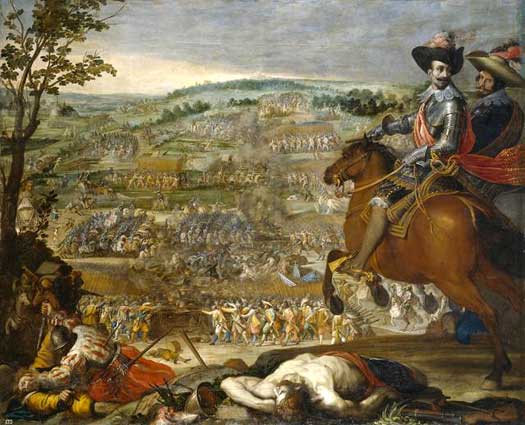 Before taking up the post of governor of Milan in 1625, Gonzalo Fernandez de Córdoba successfully defeated the mercenary forces of Ernst von Mansfeld and Christian of Brunswick at the Battle of Fleurus in 1622, part of the Thirty Years' War Before taking up the post of governor of Milan in 1625, Gonzalo Fernandez de Córdoba successfully defeated the mercenary forces of Ernst von Mansfeld and Christian of Brunswick at the Battle of Fleurus in 1622, part of the Thirty Years' War |
|
| 1625 - 1629 |
Gonzalo Fernandez de Córdoba |
Prince of Maratea. |
| 1629 - 1630 |
Ambrogio Spinola |
Died. |
| 1630 - 1631 |
Álvaro de Bazán |
|
| 1631 - 1633 |
Gómez Suárez de Figueroa |
Duke of Feria. Second term of office. |
| 1633 - 1634 |
Cardinal-Infante Ferdinand |
Son of Phillip III of Spain. Governor of Spanish Netherlands (1634). |
| 1634 - 1635 |
Cardinal Gil de Albornoz |
Archbishop of Taranto. |
| 1635 - 1636 |
Diego Felipez de Guzmán |
Viceroy of Catalonia (1645-1648). |
| 1636 |
Fernando Afán de Ribera |
Duke of Alcalá de los Gazules. Died. |
| 1636 - 1641 |
Diego Felipez de Guzmán |
Second term of office. |
| 1641 - 1643 |
Juan de Velasco |
Count of Siruela. |
| 1643 - 1646 |
Antonio Sancho Davila |
|
| 1646 - 1648 |
Bernardino Fernández de Velasco |
Duke of Frías. Viceroy of Aragon (1645-1647). |
| 1648 - 1656 |
Luis de Benavides Carrillo |
Governor of the Spanish Netherlands (1659-1664). |
| 1656 |
Cardinal Gian Giacomo Teodoro Trivulzio |
Viceroy of Aragon (1642),Sardinia (1649), &[Sicily](ItalySicily.htm#Aragons United) (1647). |
| 1656 - 1660 |
Alfonso Pérez de Vivero |
Count of Fuensaldaña. |
| 1660 - 1662 |
Francesco Caetani |
Duke of Sermoneta. Viceroy of[Sicily](ItalySicily.htm#Aragons United) (1662-1667). |
| 1662 - 1668 |
Luis de Guzmán Ponce de Leon |
Died. |
| 1668 |
Paolo Spinola |
|
| 1668 |
Francisco de Orozco |
|
| 1669 - 1670 |
Paolo Spinola |
Second term of office. |
| 1670 - 1674 |
Gaspar Téllez-Girón |
Duke de Osuna. Viceroy of Catalonia (1667-1669). |
| 1674 - 1678 |
Claude Lamoral |
Prince of Ligne. Viceroy of[Sicily](ItalySicily.htm#Aragons United) (1670-1674). |
| 1678 - 1686 |
Juan Henríquez de Cabrera |
Count of Melgar. Viceroy of Catalonia (1688). |
| 1686 - 1691 |
Antonio López de Ayala Velasco |
Viceroy of Navarre, &Sardinia (1682). Governor of Galicia. |
| 1691 - 1698 |
Diego Dávila Mesía y Guzmán |
|
| 1698 - 1706 |
Prince Charles Henry |
Count of Lorraine-Vaudemont. |
| 1702 - 1715 |
Spain is involved in the War of Succession as [Austria](GermanyAustria.htm#Habsburg Archdukes),Britain, and [Portugal](IberiaPortugal.htm#Kingdom of Braganza) dispute the Bourbon accession. Milan falls to Austria as early as 1706, allowing Austrian domination in northern Italy. The conclusion of the war sees Spain giving up Milan, Naples, Sardinia, and the Spanish Netherlands (modern Belgium) to Austria (to become known as the Austrian Netherlands), and [Sicily](ItalySicily.htm#Aragons United) to the duchy of Savoy. The Papal States are forced to hand over the territories of Parma and Piacenza to Austria, a definite blow to the papacy's prestige. Philip, duke of Anjou, is recognised as the Bourbon King Philip V of Spain, but only on the condition that the Bourbon crowns of Spain and France can never be united under a single ruler. Austria becomes the dominant power in Italy. |
|
|
|
|
| Austrian Governors of the Duchy of Milan AD 1706 - 1796 [Austria](GermanyAustria.htm#Habsburg Archdukes) replaced Spain as the dominant power in Italy as a direct result of the War of Spanish Succession. Milan fell to Austria as early as 1706, allowing Austrian domination in northern Italy. Austrian nobles ruledNaples. Austrian governors replaced Spanish governors in the duchy of Milan, and Austria gained control of Sardinia (briefly), before it had to be handed over to Savoy. This made the Savoyards much more important players in Italian politics, ultimately overseeing its unification. With Milan being one of the most important cities in northern Italy, it essentially became Austria's capital just as it had been one of Spain's major centres, and its governors were amongst the most senior figures in the peninsula, frequently being related to the AustrianHoly Roman Emperor himself. |
|
|
| 1706 - 1716 |
Prince Eugene of Savoy |
First [Habsburg](GermanyAustria.htm#Habsburg Archdukes) governor of Milan. |
| 1717 - 1720 |
King Philip V of Spain is unhappy with the arrangements set at the end of the War of Succession and occupies Sardinia and [Sicily](ItalySicily.htm#Aragons United), triggering the War of the Quadruple Alliance. The war ends in 1719, and as part of the Treaty of The Hague of 1720, the duke of Savoy gains Sardinia and is promoted to the rank of king. [Austria](GermanyAustria.htm#Habsburg Archdukes) gains the important island of Sicily in return. |
|
| 1717 - 1719 |
Prince Maximilian Karl |
Count of Löwenstein-Wertheim. Died. |
| 1719 - 1725 |
Count Girolamo Colloredo |
|
| 1725 - 1734 |
Count Wirich Philipp von Daun |
[Austrian](GermanyAustria.htm#Habsburg Archdukes) field-marshal. Former governor of Netherlands. |
| 1734 - 1736 |
As part of the wider War of the Polish Succession, Milan is occupied by theSavoyard kingdom of Sardinia. The conclusion of the conflict sees a return of [Austrian](GermanyAustria.htm#Habsburg Archdukes) officials to Milan while Naples and [Sicily](ItalySicily.htm#Aragons United) are gained by the Bourbons ofSpain. The Spanish Philip V reunites his possessions as the kingdom of the [Two Sicilies](ItalySicily.htm#Two Sicilies) and gives them to a younger son under an agreement that states that the kingdom will not be reunited with Spain. In exchange, Holy Roman Emperor Charles VI gains the duchy of Parma in addition to his existing Italian possessions. |
|
| 1736 - 1743 |
Otto Ferdinand von Abensberg und Traun |
[Austrian](GermanyAustria.htm#Habsburg Archdukes) field-marshal. Former governor of [Sicily](ItalySicily.htm#Aragons United) (1732). |
| 1743 - 1745 |
Prince Georg Christian von Lobkowitz |
|
| 1745 |
Again as part of a wider war, this time the War of the Austrian Succession,Spanish troops seize Milan under the command of Captain General Jean Thierry du Mont, count of Gages. As an occupying authority, he is shown in red, below. 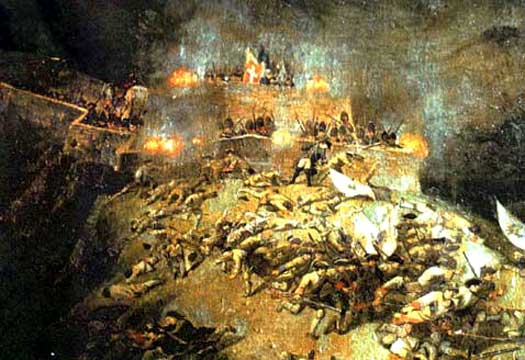 The French attempted to invade Savoy-Piedmont as part of the War of the Austrian Succession, resulting in the disastrous Battle of Assietta in which the French were massacred and their commander, Chevalier de Belle-Isle, was killed The French attempted to invade Savoy-Piedmont as part of the War of the Austrian Succession, resulting in the disastrous Battle of Assietta in which the French were massacred and their commander, Chevalier de Belle-Isle, was killed |
|
| 1745 - 1746 |
Captain General Jean Thierry du Mont |
Count of Gages.Spanish commander of occupied Milan. |
| 1745 - 1746 |
[Austrian](GermanyAustria.htm#Habsburg Archdukes) forces rally, and retake the duchy on 18 March 1746. Furthermore, they defeat the Spanish at Piacenza on 16 June 1746 and Tidone on 10 August 1746, securing their hold on Milan. |
|
| 1745 - 1747 |
Gian Luca Pallavicini |
Official [Austrian](GermanyAustria.htm#Habsburg Archdukes) governor duringSpanish occupation of 1745. |
| 1747 - 1750 |
Count Ferdinand Bonaventura von Harrach |
|
| 1750 - 1754 |
Gian Luca Pallavicini |
|
| 1754 - 1771 |
Francis III |
Duke of Modena & Reggio. Administrator of [Austrian](GermanyAustria.htm#Habsburg Archdukes) Lombardy. |
| 1754 - 1765 |
Archduke Peter Leopold |
Titular duke. Later grand duke of Tuscany &HRE Leopold II (1790). |
| 1765 - 1771 |
Archduke Ferdinand |
Titular duke. Gained governorship in 1771. |
| 1771 - 1796 |
Archduke Ferdinand |
Last [Austrian](GermanyAustria.htm#Habsburg Archdukes) governor of Milan. |
| 1792 - 1796 |
The Savoyard kingdom ofSardinia joins the First Coalition against the[French](FranceFranks.htm#First Republic) First Republic, but this is defeated by Napoleon Bonaparte. Five days after the Battle of Lodi, 10 May 1796, Sardinia is forced to sign the Treaty of Paris. The French are given free passage through Piedmont so that they can invade Italy. Napoleon also creates two republican states, one on each side of the River Po in northern Italy. These are theCispadane republic (to the south) and the Transpadane republic (to the north). |
|
|
|
|
| Cispadane & Transpadane Republics of Italy AD 1796 - 1797 Having already swept into north-western Italy, the armies of republican [France](FranceFranks.htm#First Republic) under Napoleon Bonaparte quickly secured territory around the River Po and organised two provisional states so that recruits to bolster the army could be secured. Both states were organised along the same lines as France, in the form of republics under the administrative control of a directory. The first Italian military units were quickly formed, which is what the French really needed ahead of their confrontation with[Austria](GermanyAustria.htm#Habsburg Archdukes %28Lorraine%29) as they pushed eastwards. The territory of the Cispadane republic on the southern side of the River Po encompassed the former duchy of Modena and territory from the Papal States, and consisted of Bologna, Ferrara, Modena (its capital), and Reggio Emilia. The territory of the Transpadane republic on the northern side of the River Po was centred around the recently conquered and occupied duchy of Milan. Both republics were essentially temporary measures until the fluid political and military situation resolved itself, and neither lasted for more than thirteen months. |
|
|
| 1797 |
Napoleon Bonaparte, leader of the[French](FranceFranks.htm#First Republic) First Republic begins campaigning against[Austria](GermanyAustria.htm#Habsburg Archdukes %28Lorraine%29) in northern Italy, starting with the Battle of Rivoli on 14-15 January. His forces have now been bolstered by new Italian units, and north-western Italy is now a republican extension of France itself. The Treaty of Leoben is signed with Austria on 17 April, which leads to the loss for Austria of the Austrian Netherlands and Lombardy, but which gains it the Venetian territories of Dalmatia andIstria in return. The Transpadane republic gains the rest of conquered Venice and the Leoben treaty is confirmed and extended by the Treaty of Campo Formio, which is signed on 17 October 1797. 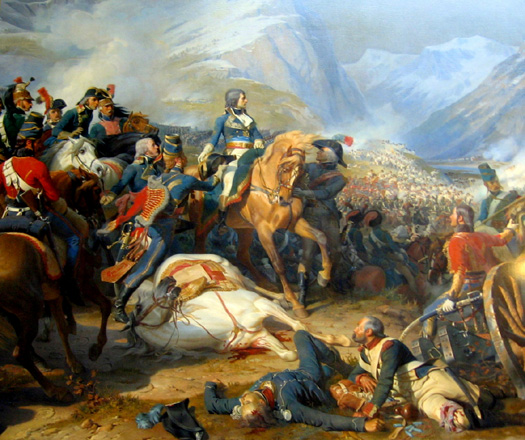 Napoleon commands at the Battle of Rivoli, 14-15 January 1797, the first French campaign in Italy against Austria Napoleon commands at the Battle of Rivoli, 14-15 January 1797, the first French campaign in Italy against Austria |
|
| 1797 |
With events in northern Italy moving at lightening pace, Napoleon adds the former duchy of Modena to the Transpadane republic, detaching it from the neighbouring Cispadane on 19 May. Just a month later, on 29 June, Napoleon reshuffles his northern Italian territories, eventually merging the Transpadane and the Cispadane together to form the greater Cisalpine republic. |
|
|
|
|
| Cisalpine Republic of Italy AD 1797 - 1802 Republican [France](FranceFranks.htm#First Republic) began the conquest of[Austria](GermanyAustria.htm#Habsburg Archdukes %28Lorraine%29)'s northern Italian territories in 1797, after gaining free passage through Piedmont. Two client republics were created out of conquered territory in north-western Italy and they were named theCispadane and Transpadane republics. A little over a year later, on 29 June, the Transpadane republic became the Cisalpine republic, again formed on French republican lines, with a directory handling administrative control. Its territory was initially divided into eleven departments and, on 27 July 1797, the Cispadine republic was merged within it, with the capital located in Milan. The republic's territory encompassed both sides of the River Po, and included Bologna, Ferrara, Milan, Modena, Reggio Emilia, and western Venice. |
|
|
| 1797 |
[ Austria](GermanyAustria.htm#Habsburg Archdukes %28Lorraine%29) acknowledges the new political situation in northern Italy with its signing of the Treaty of Campo Formio, which is signed on 17 October 1797. In exchange, Austria is confirmed in its possession of the Venetian territories of Dalmatia andIstria. |
|
| 1798 |
[French](FranceFranks.htm#First Republic) General Joubert occupies Savoy's capital at Turin and forces King Charles Emanuel IV ofSardinia to abdicate his Savoyard duchy and retire to Sardinia. Piedmont is united to France. 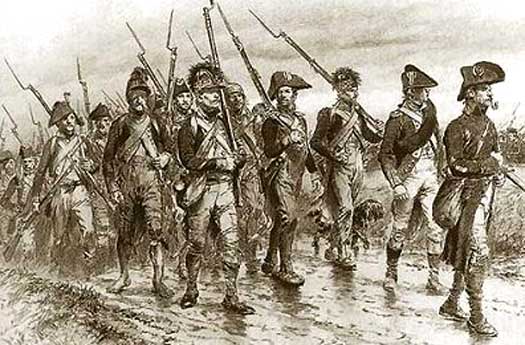 French troops occupied Turin in 1798, depriving the Savoyard kingdom of Sardinia of the greater part of its mainland territory French troops occupied Turin in 1798, depriving the Savoyard kingdom of Sardinia of the greater part of its mainland territory |
|
| In the same year, Rome is occupied by force and a Roman republic is proclaimed (1798-1799), using the territory of the Papal States. The pope is required to renounce his temporal authority, and when he refuses he is taken prisoner. He is carried off into captivity and dies shortly after his arrival in Valence. |
|
|
| 1799 - 1800 |
The Second Coalition is formed by[ Austria](GermanyAustria.htm#Habsburg Archdukes %28Lorraine%29) and Russia against[France](FranceFranks.htm#First Republic). Piedmont is captured when the allies take Turin,Monaco is freed, and the Cisalpine republic is dissolved when it is occupied by Austrians and Russians under General Suvurov. A provisional authority is appointed under Count Luigi Cocastelli. |
|
| 1799 - 1800 |
Count Luigi Cocastelli |
[ Austrian](GermanyAustria.htm#Habsburg Archdukes %28Lorraine%29) imperial commissioner. Count of Mantua. |
| 1800 |
With [French](FranceFranks.htm#First Republic) forces advancing back into Italy, Cocastelli and the allied forces withdraw on 30 May 1800. Just two weeks later, on 14 June, the Second Coalition is effectively destroyed by an[Austrian](GermanyAustria.htm#Habsburg Archdukes %28Lorraine%29) defeat at the Battle of Marengo. The French victory re-secures their client republics in the[Netherlands](FranceHolland.htm#House of Orange-Nassau) and Italy, although Napoleon has already restored the Cisalpine republic, on 4 June. 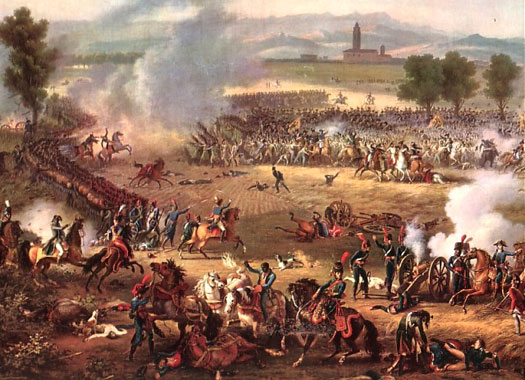 One of Napoleon's most brilliant achievements was his Italian campaign, which ended with the Battle of Marengo on 14 June 1800 - Austria was ejected from Northern Italy and French power there was now unquestioned One of Napoleon's most brilliant achievements was his Italian campaign, which ended with the Battle of Marengo on 14 June 1800 - Austria was ejected from Northern Italy and French power there was now unquestioned |
|
| 1801 |
[ Austria](GermanyAustria.htm#Habsburg Archdukes %28Lorraine%29) surrenders to France and signs the Treaty of Lunéville on 9 February 1801. As a result, the Cisalpine republic's territory expands eastwards, reaching the River Adige and the border of Austrian-controlled north-eastern Italy. |
|
| 1802 |
In January, the consuls decide to change the republic's name when Napoleon Bonaparte has himself elected as its president. TheItalian Republic is born. |
|
|
|
|
| Italian Republic AD 1802 - 1805 The Italian Republic was a short-lived successor to the[French](FranceFranks.htm#First Republic)-controlledCisalpine republic. It encompassed large areas of northern Italy, essentially Lombardy in the farther north and the Romagna area around Rome. It was entirely subservient to the French First Republic under Napoleon Bonaparte, changing its constitution to allow Napoleon to become its president at the same time as it changed its name. The capital at Milan was retained. |
|
|
| 1802 - 1805 |
Napoleon Bonaparte |
[French](FranceFranks.htm#First Republic) First Consul. 'President' of Italy. |
| 1805 |
The president of the Italian republic, Emperor Napoleon Bonaparte of [France](FranceFranks.htm#First Empire), is crowned king of Italy at a ceremony in Milan, thereby raising the republic to a kingdom. |
|
|
|
|
| Napoleonic Kingdom of Italy AD 1805 - 1814 The kingdom was proclaimed on 17 March 1805, and Napoleon Bonaparte was personally crowned king of Italy at a ceremony in Milan in May 1805 using the ancient iron crown of Lombardy. The ceremony took place just a year after he had proclaimed himself emperor of the [French](FranceFranks.htm#First Empire). His stepson and adopted son, Eugène de Beauharnais, was created viceroy of the kingdom and it was he who remained in effective control during the near-decade of the kingdom's existence. Napoleon also changed the constitution to ensure his descendents would inherit the throne. The creation of the kingdom consolidated the French acquisitions of territory from [Austria](GermanyAustria.htm#Habsburg Emperors) in Italy, namely the duchies of Mantua, Milan, and Modena, areas of the Papal States, the western section of the republic of Venice, and the province of Novara in Piedmont. On 1 May 1805, the remainder of Venice was added, along with Dalmatia andIstria. |
|
|
| 1805 - 1814 |
Eugène de Beauharnais |
Viceroy, and adopted son of Emperor Napoleon of [France](FranceFranks.htm#First Empire). |
| 1805 |
The Third Coalition is formed against [France](FranceFranks.htm#First Empire) so, in a swift campaign, Napoleon marches east and, in October, the outnumbered[Austrian](GermanyAustria.htm#Habsburg Archdukes %28Lorraine%29) army of General Mack surrenders to him without battle at Ulm in Bavaria. The French go on to occupy Vienna. On 2 December, Napoleon defeats large armies of Austrians and Russians at Austerlitz, and the coalition lies in ruins. [Bavaria](GermanyBavarians.htm#Kingdom of Bavaria) is raised to a kingdom by Napoleon. However, at sea, the Battle of Trafalgar proves once and for all Britain's supremacy, pounding the French and their Spanish allies in a crushing defeat. |
|
| 1806 |
The Bourbon kingdom of the Two Sicilies is conquered in southern Italy and the Napoleonic kingdom of[Naples](ItalyNaples.htm#Kingdom of Naples) is created in its place, incorporating much ofBenevento. Napoleon also heavily defeats Prussia and the Fourth Coalition, and liberates Prussia's holdings in Poland, forming them into an Imperial satellite state. |
|
| 1808 - 1814 |
With relations between[French](FranceFranks.htm#First Empire) Emperor Napoleon Bonaparte and the Pope deteriorating rapidly in 1808, Rome is occupied by a division of French troops. The following year the remaining Papal States are annexed to the French-controlled kingdom of Italy, including ancient Spoleto. When Pius VII subsequently excommunicates Napoleon, the French capture Castel Sant'Angelo, and a French officer breaks into the papal residence and kidnaps the pope himself. The pope remains a French captive for six years, being moved around Europe to various holding points. |
|
| 1810 |
Following a further[Austrian](GermanyAustria.htm#Habsburg Emperors) defeat in 1809, at the Battle of Wagram, [Bavaria](GermanyBavarians.htm#Kingdom of Bavaria) agrees to grant the Tyrol to Italy, whileIstria, Dalmatia and Ragusa are incorporated into the new[Illyrian Provinces](EasternCroatia.htm#Illyrian Provinces). 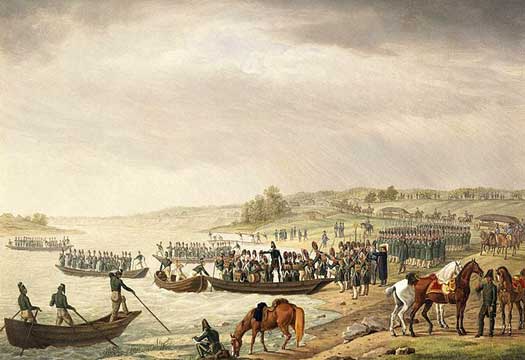 Eugène de Beauharnais led his Italian Corp over the River Niemen as part of Napoleon Bonaparte's Grande Armée and his invasion of Russia in 1812 Eugène de Beauharnais led his Italian Corp over the River Niemen as part of Napoleon Bonaparte's Grande Armée and his invasion of Russia in 1812 |
|
| 1814 |
Emperor Napoleon abdicates the thrones of[France](FranceFranks.htm#First Empire) and Italy, hoping that his infant son, Napoleon II, prince of Rome, will be allowed to succeed him in Italy. Eugène de Beauharnais prepares to defend the kingdom against an[Austrian](GermanyAustria.htm#Habsburg Emperors) invasion, but an insurrection in Milan destroys his bid to secure the throne for either Napoleon II or himself. The Great Electors disband the Senate and call for Austrian protection. Carlo Verri heads a 'Provisional Regence of Government' and Eugène surrenders on 23 April. He is exiled to [Bavaria](GermanyBavarians.htm#Kingdom of Bavaria). |
|
| 1814 |
Carlo Verri |
President of the Provisional Regence of Government. |
| 1814 |
Carlo Verri's short-lived Regence is overshadowed by the[Austrian](GermanyAustria.htm#Habsburg Emperors) imperial commission. |
|
| 1814 |
Annibale Sommariva |
[Austrian](GermanyAustria.htm#Habsburg Emperors) imperial commissioner of Lombardy, Apr-May. |
| 1814 - 1815 |
Count Heinrich Joseph von Bellegarde |
[Austrian](GermanyAustria.htm#Habsburg Emperors) supreme imperial commissioner of Lombardy. |
| 1815 |
[Austrian](GermanyAustria.htm#Habsburg Emperors) control of northern Italy is confirmed by the Congress of Vienna. The kingdom of [Lombardy-Venetia](#Austria Restored) is established under the direct control of the emperor, ending any thoughts of regional self-governance or even independence. |
|
|
|
|
| Kingdom of Lombardy-Venetia AD 1815 - 1861 With the abdication of Napoleon Bonaparte from the thrones of[France](FranceFranks.htm#First Empire) and Italy the scene was set for a renewal of[Austrian](GermanyAustria.htm#Habsburg Emperors) control of northern Italy. Despite a brief threat posed by Eugène de Beauharnais, the Austrians were able to occupy Milan on 28 April 1814, two days after appointing Annibale Sommariva as the imperial commissioner of Lombardy. A month later, on 25 May, Count Heinrich von Bellegarde assumed full control of Lombardy as supreme imperial commissioner. On 30 May the Treaty of Paris officially handed the remains of the kingdom of Italy to Austria, minus Piedmont, which was returned to Savoy, Romagna, which went back to the Papal States, Modena, which was restored to the archduke of Austria-Este, andIstria. The remainder, Lombardy and Venice, were combined into an Austrian state which fell under the direct control of the Austrian emperor and was administered by viceroys. Corsica was restored to France while Sardinia continued to be held by the Savoyards. |
|
|
| 1815 |
Prince Heinrich XV |
Prince of Reuss-Plauen. Governor of Milan. Died 1824. |
| 1815 - 1816 |
Count Heinrich Joseph von Bellegarde |
Former supreme imperial commissioner of Lombardy. Died 1845. |
| 1816 - 1818 |
Archduke Anton Victor |
Master of theTeutonic Knights. Died 1835. |
| 1816 |
Archduke Anton Victor is the son of former[Austrian](GermanyAustria.htm#Habsburg Emperors) Emperor Leopold II and the first hereditary master of theTeutonic Knights. He had also served as the last archbishop-elector of Cologne and prince-bishop of Münster before those posts had been abolished in 1803. |
|
| 1818 - 1848 |
Archduke Rainer Joseph |
Brother. Died 1853. |
| 1848 - 1849 |
In a year of European revolutions (France, Galicia, [Hessen-Darmstadt](GermanyHessenDarmstadt.htm#Grand Dukes), Ireland, Liechtenstein,Monaco, and [Wallachia](EasternWallachia.htm#Tax Farmer) also experience problems), a popular uprising known as the 'Five Days of Milan' drives out the [Austrians](GermanyAustria.htm#Habsburg Emperors) on 22 March 1848 largely, it is said, due to the resentment built up by Archduke Rainer's tax collections. Milan becomes the seat of the Provisional Government of Lombardy. On the following day, Venice experiences a similar uprising, with the Provisional Government of Venice being formed. King Charles Albert of Savoy briefly goes to war against Austria in what is a short-lived encounter. He is defeated. In the following year he tries again and is similarly defeated in quick fashion, but the two attempts become known as the First War of (Italian) Independence. |
|
| 1848 - 1857 |
Johann Wenzel |
Count Radetzky of Radetz. A fair-minded viceroy. Died 1858. |
| 1852 |
Count Camillo Benso di Cavour is installed as the new, liberal minister of theSavoyard kingdom ofSardinia, and the kingdom quickly becomes a torchbearer for Italian unification. 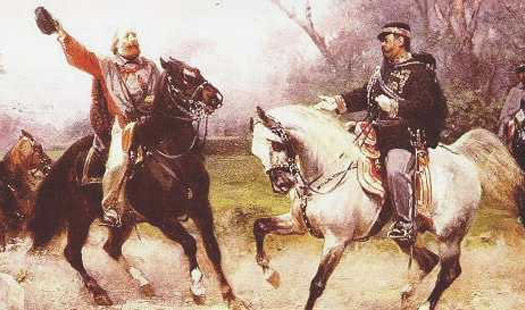 Garibaldi in his distinctive red jacket hails victory during the Italian War of Unification in which Austria was removed of its dominance of the country and a single Italian kingdom was forged in its place Garibaldi in his distinctive red jacket hails victory during the Italian War of Unification in which Austria was removed of its dominance of the country and a single Italian kingdom was forged in its place |
|
| 1857 - 1859 |
Archduke Ferdinand Maximilian Joseph |
Brother of Emperor Francis Joseph. Later emperor of Mexico. |
| 1859 |
The Second Italian War of Independence sees Lombardy taken from[Austrian](GermanyAustria.htm#Habsburg Emperors) hands. The change in ownership is ratified in the same year by the Treaty of Zurich, creating the beginnings of a unified kingdom of Italy. Venice is captured in 1866, formally terminating the Austrian kingdom of Lombardy-Venetia. |
|
|
|
|
| Kingdom of Italy (House of Savoy) AD 1861 - 1946 During 1859-1861, a politically fragmented Italy was forged by nationalist Giuseppe Garibaldi into a single kingdom. His War of Unification freed Italy from [Austrian](GermanyAustria.htm#Habsburg Emperors) control. The process of reunification had effectively begun with the Congress of Vienna in 1815, although it meant that Austrian control over large areas of Italy had to be endured for another two generations, along with the restored and fragmented regional authorities which included the fiercely protective Papal States. It took a long time before even those who supported reunification could agree on how to achieve it. One of the most feared (and soon outlawed) revolutionary groups was that of the Carbonari, the coal burners. They almost succeeded in assassinating Napoleon III of the[French Second Empire](FranceFranks.htm#Second Empire) in 1858 for his allegedly turning his back on them. With support growing, and with a secret agreement in place with France, the war soon achieved its aims. Once reunification had been achieved, the conservatively supportive Savoyard king ofSardinia became king of Italy (a title previously held by theHoly Roman Emperors), gaining Parma, [Sicily & Naples](ItalySicily.htm#Two Sicilies Reunited), and Spoleto, while at the same time handing Savoy to France as promised. In 1866 Venice was annexed to the new Italy, while the Papal States were also seized by the kingdom in 1870. Initially the capital of this newly unified state was at Savoy's old capital of Turin (between 1861-1864), but was moved to Florence, where it remained until the capture of Rome. In 1861, the kingdom was set up as a constitutional monarchy with a representative parliamentary body. During the Mussolini years, that was swept aside for a single party fascist state, between 1928-1943, and it was this that essentially sealed the kingdom's end three years later. |
|
|
| 1861 - 1878 |
Victor Emanuel II |
Formerly theSavoyard king ofSardinia (1849-1861). |
| 1866 |
Prussia fights the Austro-Prussian War against [Austria](GermanyAustria.htm#Habsburg Emperors), essentially as a decider to see which of the two powers will be dominant in Central Europe. Prussia gains Italy as an ally in the south and several minor German states in the north. Austria and its southern German allies are crushed in just seven weeks (giving the conflict its alternative title of the Seven Weeks' War), and Prussia is now unquestionably dominant. Bismark oversees the seizure of four of Austria's northern German allies, the kingdom of Hanover, the electorate of Hessen-Kassel, and the duchy of[Nassau](FranceNassau.htm#Duchy Of Nassau), along with the free city of Frankfurt. Prussia also subsumes Schleswig and Holstein and Saxe-Lauenberg, while despite being defeated in its own theatre of the war, Italy gains Venice thanks to Prussia's dominance, completely terminating the Austrian kingdom of[Lombardy-Venetia](#Austria Restored). |
|
| 1870 - 1871 |
Italy achieves full union under the House of Savoy. In 1871, Rome becomes its capital for the first time since the collapse of the WesternRoman empire (although even then, Ravenna had been the capital for some considerable time). 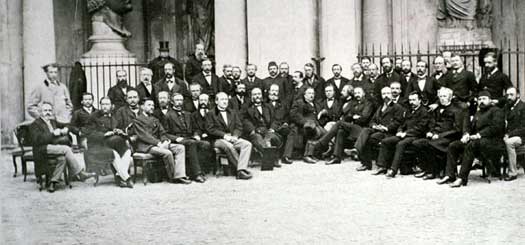 The delegates of the 1871 Plenipotentiary Conference in Rome pose for a group photo, shortly after Italy achieved full unification under the House of Savoy The delegates of the 1871 Plenipotentiary Conference in Rome pose for a group photo, shortly after Italy achieved full unification under the House of Savoy |
|
| 1878 - 1900 |
Umberto I 'the Good' |
Son. Killed by an anarchist. |
| Amadeo / Amadeus |
Brother. King of Spain (1870-1873). |
|
| 1882 |
Italy and France disagree over their respective colonial expansionism so, seeing an opportunity to isolate France, Bismarck welcomes Italy into a Triple Alliance with thePrussian-dominated German empire and [Austria](GermanyAustria.htm#Habsburg Emperors). Italian relations with Berlin now enter their best period, although Vienna remains icily formal with its former subject. |
|
| 1900 |
Umberto is assassinated by an Italo-American anarchist named Gaetano Bresci in Monza. The reason is that Bresci wanted to avenge the people killed during the Bava-Beccaris massacre in Milan in May 1898. Umberto is laid to rest in the Pantheon in Rome, alongside his father. |
|
| 1900 - 1946 |
Victor Emanuel III |
Son of Umberto I. Abdicated. |
| 1911 - 1914 |
Italy invades Ottoman Libya in 1911. An Italian protectorate is declared in 1912, and the region is governed by Italy in this fashion until 1934, when the colony of Libya is formed. Also in 1912, Albania, one of Europe's poorest states, became unexpectedly independent after the Albanian Uprising of 1912 and the First Balkan War (1912-1913). In November 1913, Albanian pro-Ottoman forces offer the Albanian throne to the Ottoman war minister, Izzet Pasha, but the provisional government executes his representative. In 1914, [Austria-Hungary](GermanyAustria.htm#Habsburg Emperors) and Italy are able to select the German Prince Wied as the first prince of an independent Albania. |
|
| 1915 - 1919 |
In the secret Treaty of London of 26 April 1915, Italy agrees to abandon its allies, Germany and[Austria-Hungary](GermanyAustria.htm#Habsburg Emperors), declaring war on them instead. Italy has been promised territory in compensation for its change of allegiance, which will certainly be at Austria's expense. With the collapse of Austria's empire at the end of the First World War, and the agreement of a ceasefire on 3 November 1918, Italy inherits the province ofIstria. The victory elevates Italy to a major power and gains it a permanent seat at the League of Nations. In 1919, Italy also gains the Canal Valley region ofCarinthia from Austria under the terms of the Treaty of St Germain. |
|
| 1922 |
The fascist leader Benito Mussolini becomes dictator of Italy and has the support (officially, at least) of the king. He also seeks to heal the breach between thePapacy and the state, an act that will strengthen his position, but this takes until 1929 to achieve. Totalitarian rule is established over the country and political and intellectual opposition is crushed. 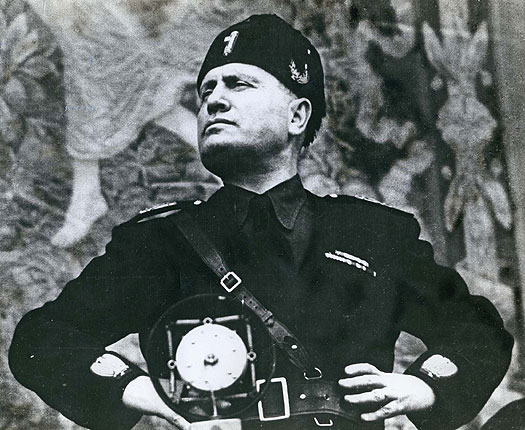 Would-be creator of an Italian empire but largely possessing second-rate military forces, Benito Mussolini as 'Il Duce' became the country's dictatorial leader in the run-up to the Second World War Would-be creator of an Italian empire but largely possessing second-rate military forces, Benito Mussolini as 'Il Duce' became the country's dictatorial leader in the run-up to the Second World War |
|
| 1929 |
ThePope and Mussolini sign the Lateran Treaty, finally settling the breach between the Italian government and the papacy that has existed since the seizure of the Papal States in 1870. The treaty establishes the independent Vatican City State. |
|
| 1936 - 1939 |
In 1936 Italy formally annexes Ethiopia after a short military campaign in which mustard gas is used. For much of the [**Spanish**](IberiaSpain.htm#Second Republic) Civil War both Germany and Italy supply weapons and even aircraft to General Franco's forces. |
|
| 1939 - 1941 |
Italy invades and occupies Albania in 1939. The following year it demands to be allowed to station troops in Greece, but the Greek king refuses. The resultant Greco-Italian War is a victory for Greece, with southern Albania also being occupied. Nazi Germany is forced to intervene, invading Greece in 1941 and capturing it. In the same year, the USA and Cuba enter the war against Italy and on the side of the allies. 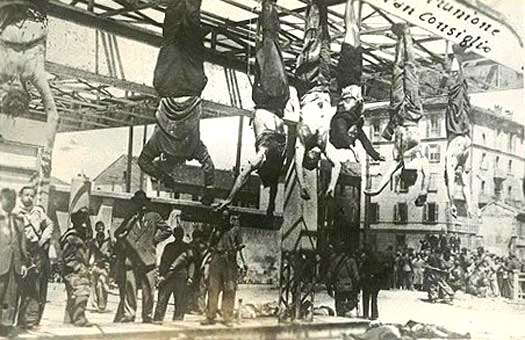 Mussolini (fourth from the left) and his chief henchmen were hanged by their heels by the partisans, along with Mussolini's mistress, Claretta Petacci (to the right of him) Mussolini (fourth from the left) and his chief henchmen were hanged by their heels by the partisans, along with Mussolini's mistress, Claretta Petacci (to the right of him) |
|
| 1942 |
Italy already exercises considerable control over Monaco but, in 1942, it formally occupies the principality and establishes a puppet state. Prince Louis of Monaco forces Benito Mussolini to promise not to deport Jews, many of whom have taken refuge there. |
|
| 1943 - 1945 |
The Italian fleet surrenders at Valetta, Malta, on 10 September 1943, givingBritain's Royal Navy control of the Mediterranean. With the collapse and surrender of the Italians, northern and central Italy is occupied by Nazi Germans (Monaco too). Mussolini is summarily executed the day after he is captured by communist partisans on 27 April 1945, as he attempts to escape toSwitzerland. |
|
| 1946 |
Umberto II |
Son. Succeeded 9 May, abdicated 12 June. |
| 1946 |
A constitutional referendum is held in the country and Italians take the decision to form a republic. The king is forced into exile as punishment for his support of Mussolini. |
|
|
|
|
| Modern Italy AD 1946 - Present Day The modern country of Italy occupies the entire Italian peninsula in Southern Europe, along with the major islands ofSardinia andSicily. It is neighboured to the north-west by France, to the north by Switzerland andAustria, to the north-east by Slovenia, withAlbania the closest country to it along the Adriatic Sea,Tunisia approximately 150 kilometres to the south-west of Sicily, and Corsica just off the western coast, across the Tyrrhenian Sea. Italy's Early Cultures provide the archaeological evidence to support various legends, tales, and histories regarding the peninsula's ancient tribes and groups. These people includeEtruscans,Italics,Latins,Alpines,Ligurians,Celts and, of course,Romans. However, it took time for Roman domination to emerge: the city itself did not even exist whenIron Age Italy replaced the Bronze Age. Rome dominated Italy for the best part of six hundred years, but its fading and termination took place at the dawn of theMedieval period. With the kingdom of Italy fatally undermined by its association with fascism, the Italian monarchy was formally brought to an end on 12 June 1946. King Umberto II ruled for just thirty-three days before he stepped down and handed power to the prime minister as interim head of state. Umberto left Italy, never to return, living for another thirty-seven years and becoming 'Europe's grandfather' at many royal weddings over the years. After his death a succession dispute arose concerning the next most senior claimant to the lost Italian throne, although most authorities sided with Victor Emanuel. The Italian republic was formed in place of the kingdom, with a referendum being held on 2 June 1946 to decide the fact. Within Italian territory, two independent enclaves remain, vestiges of Italy's politically fragmented history from the time of the collapse of theRoman empire onwards. Vatican City is the modern remnants of thePapal States, while San Marino is a republic with origins as far back as AD 301. Successive claimants to the Italian throne are given a shaded background, while rival claimants are shown in green text. (Additional information from External Link: Descendants of Italy�s last king (The Guardian).) |
|
|
| 1946 - 1983 |
Umberto II |
Exiled king of Italy. Died 18 March. |
| 1947 - 1949 |
Italy loses sections of its eastern border toYugoslavia under the terms of the Paris Peace Treaties. The following year, the first governmental elections are held with the threat of a possible Communist takeover serving as an incentive to ensure the preservation of democracy. |
|
| 1949 |
Italy joins Nato. Despite the country's now strongly-established democratic credentials, the political stability of each successive government is precarious, and several dozen of them come and go during the second half of the twentieth century. |
|
| 1954 |
Trieste has been occupied by British, US, and Yugoslav forces since the end of the Second World War. On 26 October 1954 its control is permanently divided between Italy and Yugoslavia. |
|
| 1957 |
Italy is a founding member of the European Economic Community, which later evolves into the European Union.  With tourism being one of Italy's biggest industries, the slow sinking of the islets upon which Venice sits presents a serious problem With tourism being one of Italy's biggest industries, the slow sinking of the islets upon which Venice sits presents a serious problem |
|
| 1983 - Present |
Victor Emanuel IV |
Son. Prince of Naples. Born 12 Feb 1937. |
| 2003 |
The hereditary king of Italy, Victor Emanuel, returns to Italy, fifty-six years after the House of Savoy had been forced into exile. |
|
| 2006 - Present |
Prince Amedeo of Savoy |
Cousin. Duke of Aosta. Born 27 Sep 1943. Rival claimant. |
| 2006 |
Prince Amedeo of Savoy is the son of Aimone of Spoleto, Mussolini's puppet king of Croatia (1941-1943). In an attempt to secure the title for himself, Amedeo on 7 July 2006 declares himself head of the House of Savoy and duke of Savoy, claiming that Victor Emanuel had lost his claim when he married without Umberto's permission in 1971. |
|
| 2022 |
The Savoyard family sue the Italian state in February 2022 to reclaim the crown jewels. For almost seventy-eight years these have been stashed in a safety deposit box at the Bank of Italy amid a long-running saga over their ownership. |
|
| 2025 |
An Italian court rejects the Savoyard claim to gain ownership of the crown jewels. The civil court throws out the bid on Thursday 15 May 2025 to gain recognition for Savoyard ownership rights, describing the claim as 'manifestly unfounded'. |
|
| Emanuel Filiberto |
Son of Victor Emanuel IV. Born 22 June 1972. |
|
 |
|
|
 Formed by a relatively narrow peninsula which emerges into the Mediterranean from southern Europe, Italy is characterised by a rugged central spine of mountains, the Apennines, which are bordered either side by fertile plains and valleys (see feature link for more on the naming of the Apennines). This mountain range has a surface area of 301,230 square kilometres, including the islands of Sardinia and Sicily. Archaeological investigation shows signs of Heidelbergensis and Neanderthal occupation, with modern humans arriving around 38,000 BC. During the last ice age, water levels in the Mediterranean were lower than they are today, allowing land bridges to form to the islands of Elba and Sicily, and leaving the northern half of the Adriatic as a fertile plain. The human hunter-gatherers of Palaeolithic Early Italy prospered until the end of the most recent ice age around 10,000 BC, when large game became harder to find. The Italian Neolithic - which is somewhat poorly catalogued - began with the introduction of pottery and the later Gaudo culture in southern Italy, before these both gave way to the Italian Bronze Age. Just as the Etruscans were achieving regional and cultural dominance outside the peninsula's Greek colony areas, West Indo-European proto-Italic groups later drifted southwards to establish tribal holdings. Italy experienced considerable change between the twelfth to eighth centuries BC, but the basis of the Roman republic and subsequent empire were laid by this migration. However, it took time for Roman domination to emerge, and that was far from guaranteed. The city itself did not even exist whenIron Age Italy replaced the Bronze Age. The Greek colonies were initially full independent of outside domination, and it is possibly due to their influence that the peninsula is known as 'Italia' instead of 'vitalia' (pronounced 'witalia'). It seems likely that this is due to Greek having no 'w', and a 'w' where it does exist often gets dropped. The result is 'Italia'. Rome eventually dominated Italy for the best part of six hundred years, but its fading and termination led to a series of invasions and relatively short-lived rulers which served to divide the country into a patchwork of states. By then, however, Italy's Iron Age had already given way to its Medieval period. (Information by Peter Kessler, with additional information by Edward Dawson.)
Formed by a relatively narrow peninsula which emerges into the Mediterranean from southern Europe, Italy is characterised by a rugged central spine of mountains, the Apennines, which are bordered either side by fertile plains and valleys (see feature link for more on the naming of the Apennines). This mountain range has a surface area of 301,230 square kilometres, including the islands of Sardinia and Sicily. Archaeological investigation shows signs of Heidelbergensis and Neanderthal occupation, with modern humans arriving around 38,000 BC. During the last ice age, water levels in the Mediterranean were lower than they are today, allowing land bridges to form to the islands of Elba and Sicily, and leaving the northern half of the Adriatic as a fertile plain. The human hunter-gatherers of Palaeolithic Early Italy prospered until the end of the most recent ice age around 10,000 BC, when large game became harder to find. The Italian Neolithic - which is somewhat poorly catalogued - began with the introduction of pottery and the later Gaudo culture in southern Italy, before these both gave way to the Italian Bronze Age. Just as the Etruscans were achieving regional and cultural dominance outside the peninsula's Greek colony areas, West Indo-European proto-Italic groups later drifted southwards to establish tribal holdings. Italy experienced considerable change between the twelfth to eighth centuries BC, but the basis of the Roman republic and subsequent empire were laid by this migration. However, it took time for Roman domination to emerge, and that was far from guaranteed. The city itself did not even exist whenIron Age Italy replaced the Bronze Age. The Greek colonies were initially full independent of outside domination, and it is possibly due to their influence that the peninsula is known as 'Italia' instead of 'vitalia' (pronounced 'witalia'). It seems likely that this is due to Greek having no 'w', and a 'w' where it does exist often gets dropped. The result is 'Italia'. Rome eventually dominated Italy for the best part of six hundred years, but its fading and termination led to a series of invasions and relatively short-lived rulers which served to divide the country into a patchwork of states. By then, however, Italy's Iron Age had already given way to its Medieval period. (Information by Peter Kessler, with additional information by Edward Dawson.) This half-siliqua was the only silver coinage issued during the short reign of Romulus Augustus, puppet and final official Western Roman emperor
This half-siliqua was the only silver coinage issued during the short reign of Romulus Augustus, puppet and final official Western Roman emperor Ravenna had been the home of the last Roman emperors, as well as the capital of the succeeding Goths and Ostrogoths, before serving the same role for the Eastern Romans
Ravenna had been the home of the last Roman emperors, as well as the capital of the succeeding Goths and Ostrogoths, before serving the same role for the Eastern Romans Although unconfirmed, the mosaic in the Basilica of San Vitale that depicts Emperor Justinian and his entourage includes this man who is usually identified as General Narses
Although unconfirmed, the mosaic in the Basilica of San Vitale that depicts Emperor Justinian and his entourage includes this man who is usually identified as General Narses An artist's impression of mixed Lombard infantry and cavalry in action, exhibiting Late Roman and Germanic features in their dress and weapons
An artist's impression of mixed Lombard infantry and cavalry in action, exhibiting Late Roman and Germanic features in their dress and weapons This light solidus was minted during the reign of Emperor Constans II, with his bearded face on the obverse (left) and a cross potent on three steps on the reverse (right)
This light solidus was minted during the reign of Emperor Constans II, with his bearded face on the obverse (left) and a cross potent on three steps on the reverse (right) During the two centuries of Byzantine dominance in eastern Italy, the Eastern Romans left behind a good deal of their Greek-based culture, including these mosaics at Ravenna
During the two centuries of Byzantine dominance in eastern Italy, the Eastern Romans left behind a good deal of their Greek-based culture, including these mosaics at Ravenna Charlemagne unified all the Frankish states under one ruler and created an empire which stretched deep into modern Germany, something that the Romans had never managed
Charlemagne unified all the Frankish states under one ruler and created an empire which stretched deep into modern Germany, something that the Romans had never managed This denier was issued in Italy during the reign of Louis II, ruler of Middle Francia and nominal emperor of the Frankish realms, and was minted at Benevento
This denier was issued in Italy during the reign of Louis II, ruler of Middle Francia and nominal emperor of the Frankish realms, and was minted at Benevento Charles 'the Fat' (not necessarily living up to his descriptive sobriquet) welcomes messengers into his tent as titular head of the Frankish empire, as depicted in the fourteenth century Grandes Chroniques de France
Charles 'the Fat' (not necessarily living up to his descriptive sobriquet) welcomes messengers into his tent as titular head of the Frankish empire, as depicted in the fourteenth century Grandes Chroniques de France The determined Berengar of Friuli not only controlled the march territory between Italy proper and the Avars and Magyars to the east, but also claimed the Italian throne no less than three times during his eventful life
The determined Berengar of Friuli not only controlled the march territory between Italy proper and the Avars and Magyars to the east, but also claimed the Italian throne no less than three times during his eventful life Berengar is defeated by the Saxon king of Germany, Otto I and imperial control is subsequently restored on Corsica (by 965). Italy is officially incorporated into theHoly Roman empire.
Berengar is defeated by the Saxon king of Germany, Otto I and imperial control is subsequently restored on Corsica (by 965). Italy is officially incorporated into theHoly Roman empire.  Otto accepts the surrender of Berengar of Ivrea in 961 to become undisputed German emperor, shown in this early thirteenth century text called the Manuscriptum Medioalense
Otto accepts the surrender of Berengar of Ivrea in 961 to become undisputed German emperor, shown in this early thirteenth century text called the Manuscriptum Medioalense The Battle of Legnano on 29 May 1176 ended the hopes of Holy Roman Emperor Frederick Barbarossa of dominating Italy following his defeat by the Lombard League
The Battle of Legnano on 29 May 1176 ended the hopes of Holy Roman Emperor Frederick Barbarossa of dominating Italy following his defeat by the Lombard League Medieval Italy was a cauldron of competing city states, with unceasing competition between them that sparked the Renaissance and a blossoming of culture and advancement
Medieval Italy was a cauldron of competing city states, with unceasing competition between them that sparked the Renaissance and a blossoming of culture and advancement Although Sforzesco Castle was only transformed into a ducal palace by its namesake, Francesco Sforza, in 1450, its origins date to the time of Galeazzo II Visconti
Although Sforzesco Castle was only transformed into a ducal palace by its namesake, Francesco Sforza, in 1450, its origins date to the time of Galeazzo II Visconti A portrait of Gian Galeazzo I Visconti, first duke of Milan during the politically troubled early Renaissance period in Italy in which he was able to purchase his title and domains
A portrait of Gian Galeazzo I Visconti, first duke of Milan during the politically troubled early Renaissance period in Italy in which he was able to purchase his title and domains The ill-fated Ottaviano Maria Sforza, who opposed the restoration of Ugo, count of Lugano, and soon afterwards was drowned while attempting to avoid arrest, was painted in oils by Botticelli
The ill-fated Ottaviano Maria Sforza, who opposed the restoration of Ugo, count of Lugano, and soon afterwards was drowned while attempting to avoid arrest, was painted in oils by Botticelli Holy Roman Emperor Charles V is depicted wearing a laurel crown on the obverse of this silver medallic 'testone' which was struck by the duchy of Milan in homage to him
Holy Roman Emperor Charles V is depicted wearing a laurel crown on the obverse of this silver medallic 'testone' which was struck by the duchy of Milan in homage to him Before taking up the post of governor of Milan in 1625, Gonzalo Fernandez de Córdoba successfully defeated the mercenary forces of Ernst von Mansfeld and Christian of Brunswick at the Battle of Fleurus in 1622, part of the Thirty Years' War
Before taking up the post of governor of Milan in 1625, Gonzalo Fernandez de Córdoba successfully defeated the mercenary forces of Ernst von Mansfeld and Christian of Brunswick at the Battle of Fleurus in 1622, part of the Thirty Years' War The French attempted to invade Savoy-Piedmont as part of the War of the Austrian Succession, resulting in the disastrous Battle of Assietta in which the French were massacred and their commander, Chevalier de Belle-Isle, was killed
The French attempted to invade Savoy-Piedmont as part of the War of the Austrian Succession, resulting in the disastrous Battle of Assietta in which the French were massacred and their commander, Chevalier de Belle-Isle, was killed Napoleon commands at the Battle of Rivoli, 14-15 January 1797, the first French campaign in Italy against Austria
Napoleon commands at the Battle of Rivoli, 14-15 January 1797, the first French campaign in Italy against Austria French troops occupied Turin in 1798, depriving the Savoyard kingdom of Sardinia of the greater part of its mainland territory
French troops occupied Turin in 1798, depriving the Savoyard kingdom of Sardinia of the greater part of its mainland territory One of Napoleon's most brilliant achievements was his Italian campaign, which ended with the Battle of Marengo on 14 June 1800 - Austria was ejected from Northern Italy and French power there was now unquestioned
One of Napoleon's most brilliant achievements was his Italian campaign, which ended with the Battle of Marengo on 14 June 1800 - Austria was ejected from Northern Italy and French power there was now unquestioned Eugène de Beauharnais led his Italian Corp over the River Niemen as part of Napoleon Bonaparte's Grande Armée and his invasion of Russia in 1812
Eugène de Beauharnais led his Italian Corp over the River Niemen as part of Napoleon Bonaparte's Grande Armée and his invasion of Russia in 1812 Garibaldi in his distinctive red jacket hails victory during the Italian War of Unification in which Austria was removed of its dominance of the country and a single Italian kingdom was forged in its place
Garibaldi in his distinctive red jacket hails victory during the Italian War of Unification in which Austria was removed of its dominance of the country and a single Italian kingdom was forged in its place The delegates of the 1871 Plenipotentiary Conference in Rome pose for a group photo, shortly after Italy achieved full unification under the House of Savoy
The delegates of the 1871 Plenipotentiary Conference in Rome pose for a group photo, shortly after Italy achieved full unification under the House of Savoy Would-be creator of an Italian empire but largely possessing second-rate military forces, Benito Mussolini as 'Il Duce' became the country's dictatorial leader in the run-up to the Second World War
Would-be creator of an Italian empire but largely possessing second-rate military forces, Benito Mussolini as 'Il Duce' became the country's dictatorial leader in the run-up to the Second World War Mussolini (fourth from the left) and his chief henchmen were hanged by their heels by the partisans, along with Mussolini's mistress, Claretta Petacci (to the right of him)
Mussolini (fourth from the left) and his chief henchmen were hanged by their heels by the partisans, along with Mussolini's mistress, Claretta Petacci (to the right of him) With tourism being one of Italy's biggest industries, the slow sinking of the islets upon which Venice sits presents a serious problem
With tourism being one of Italy's biggest industries, the slow sinking of the islets upon which Venice sits presents a serious problem